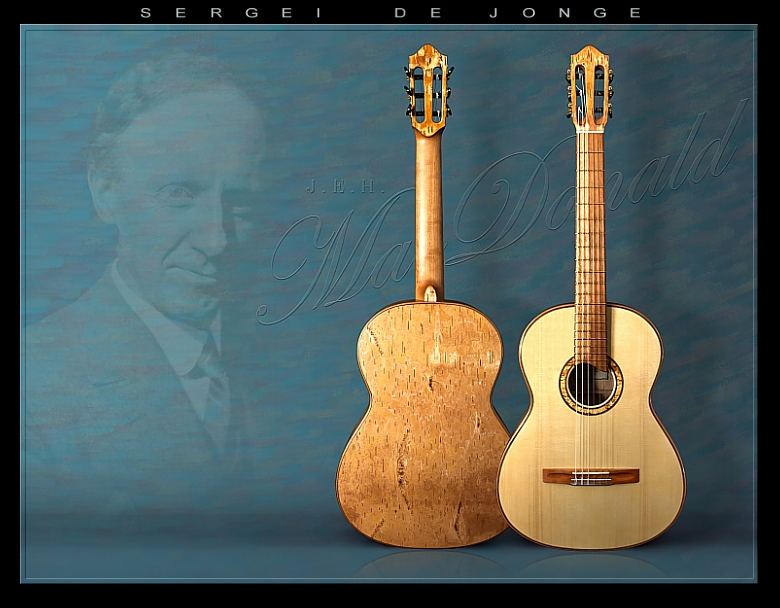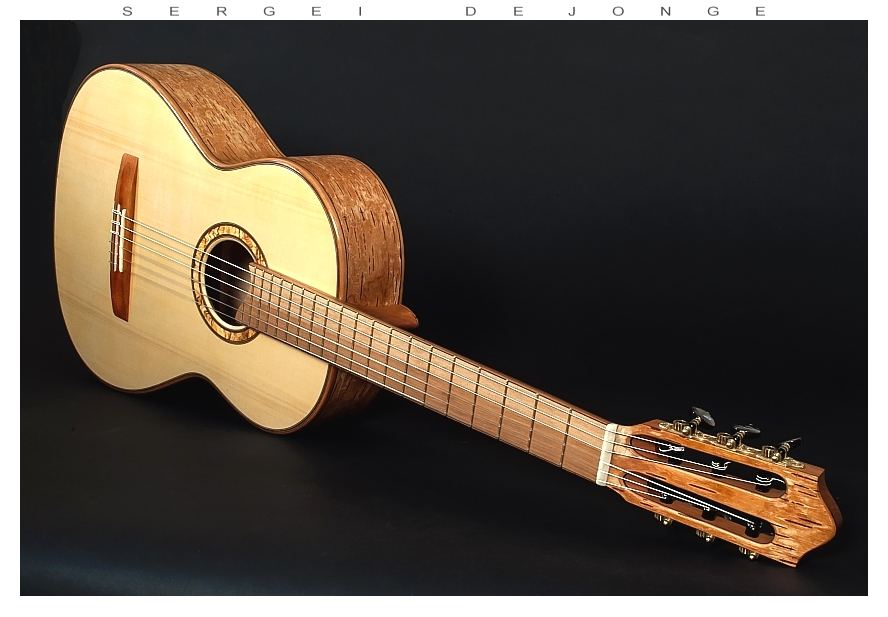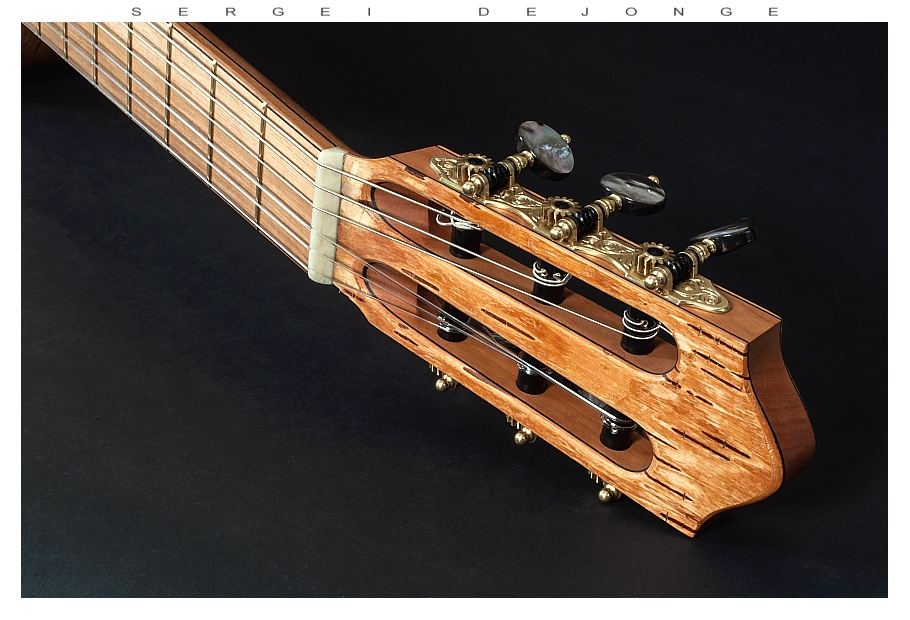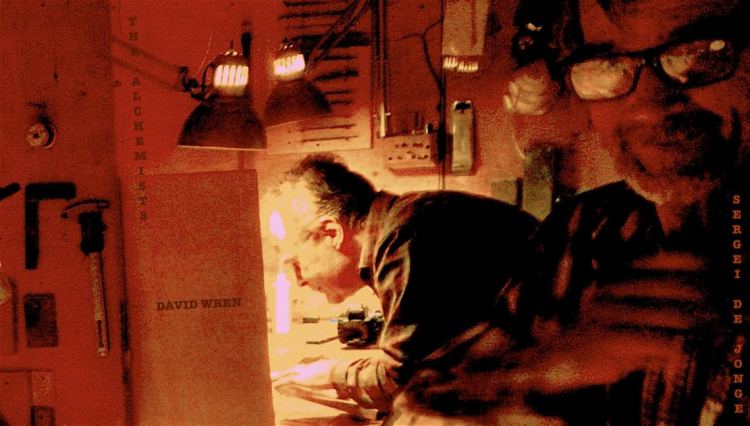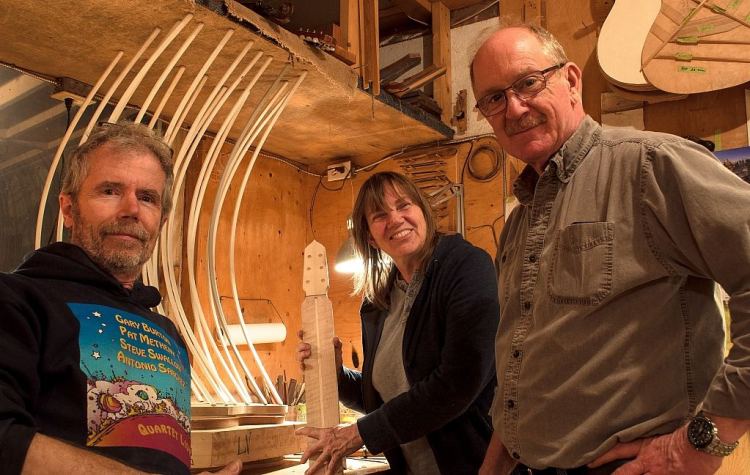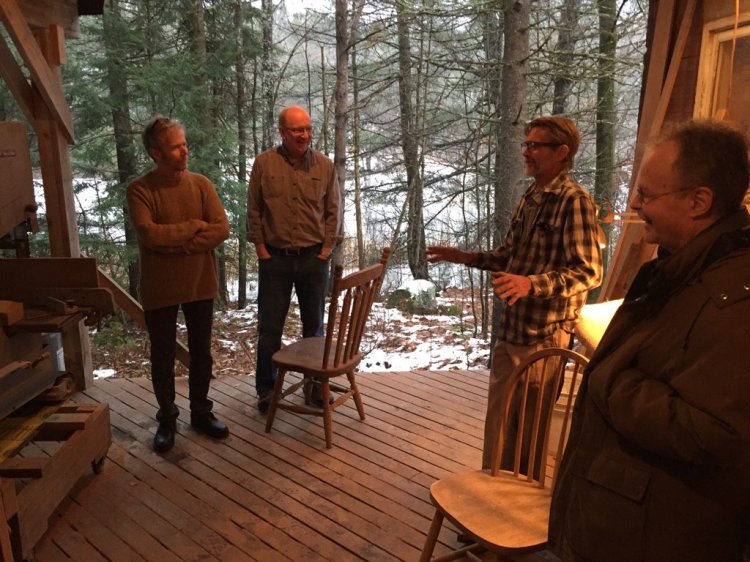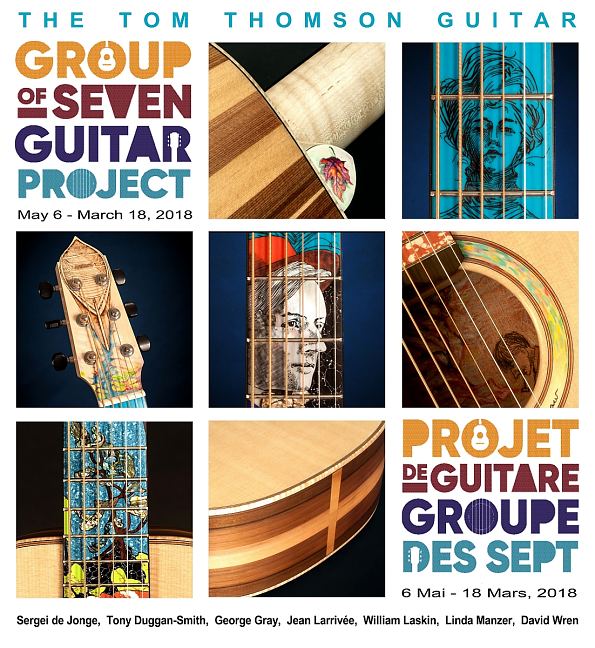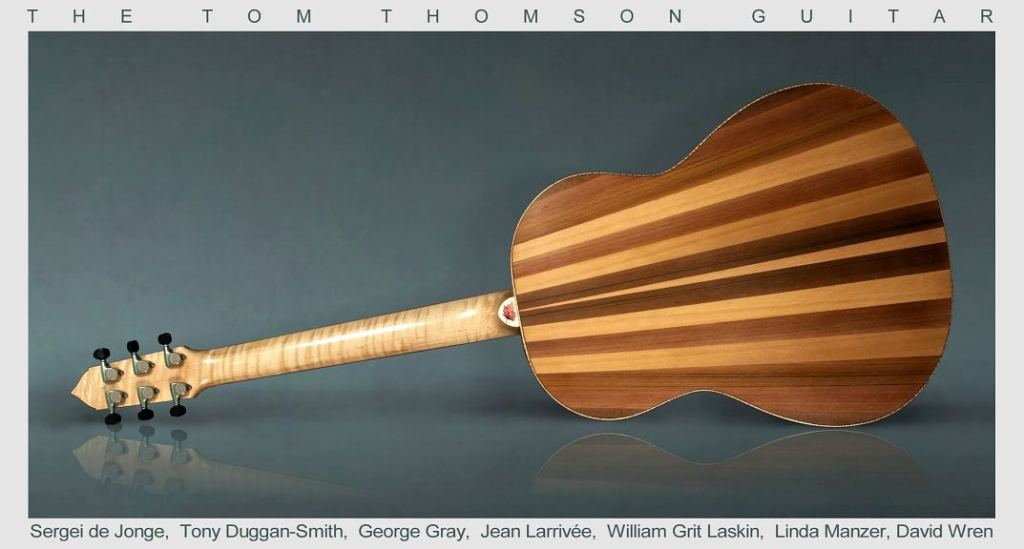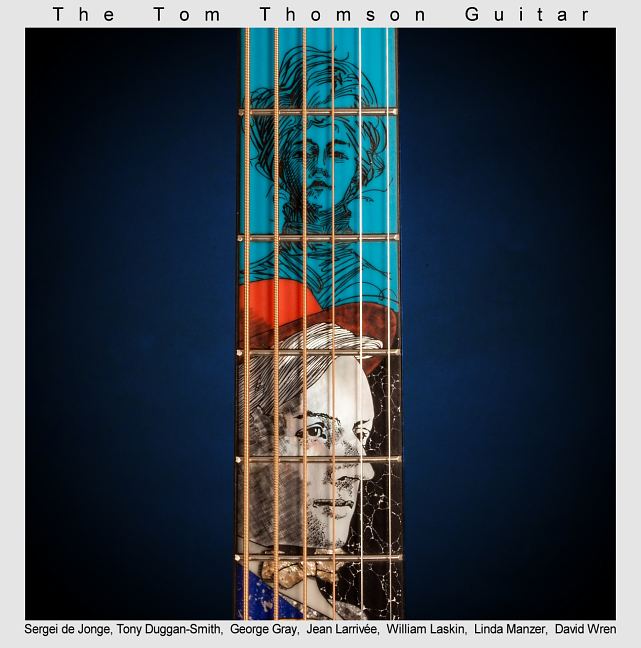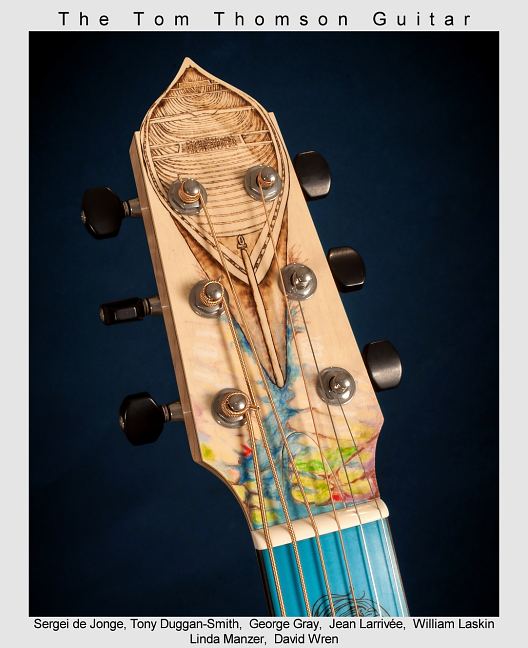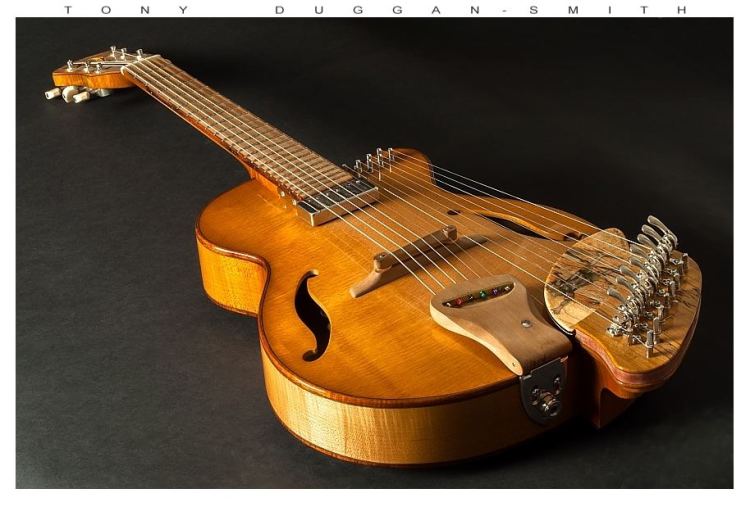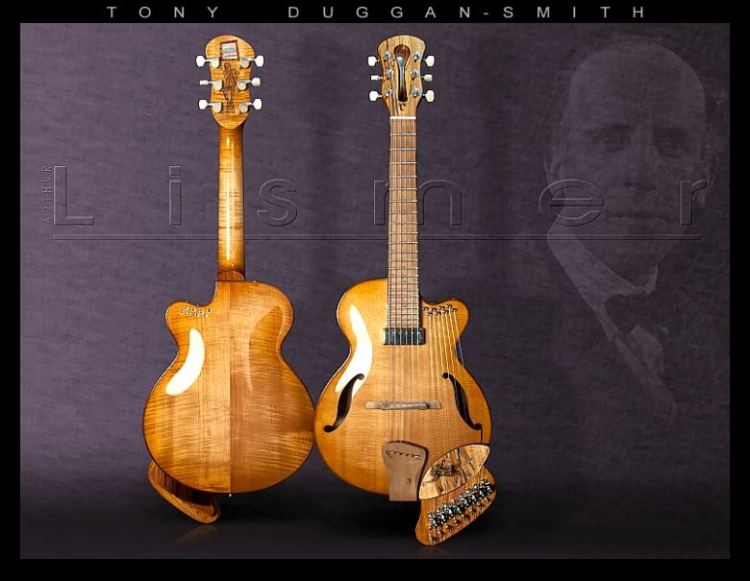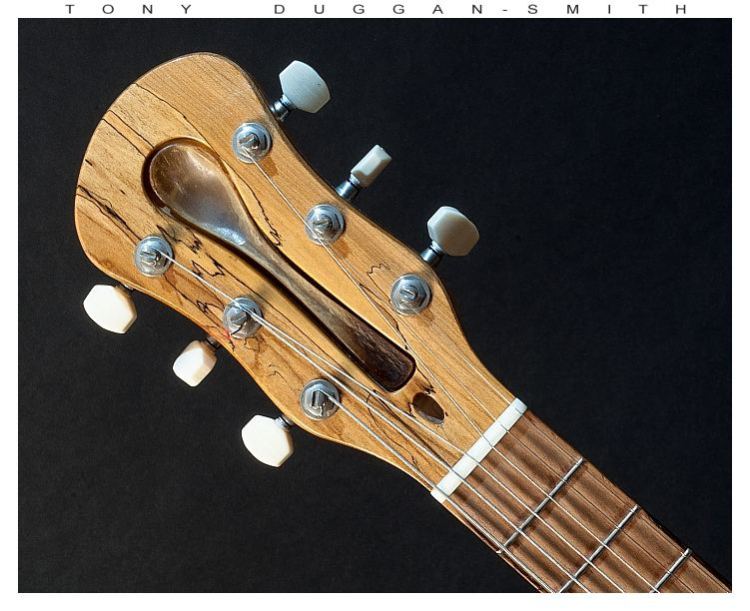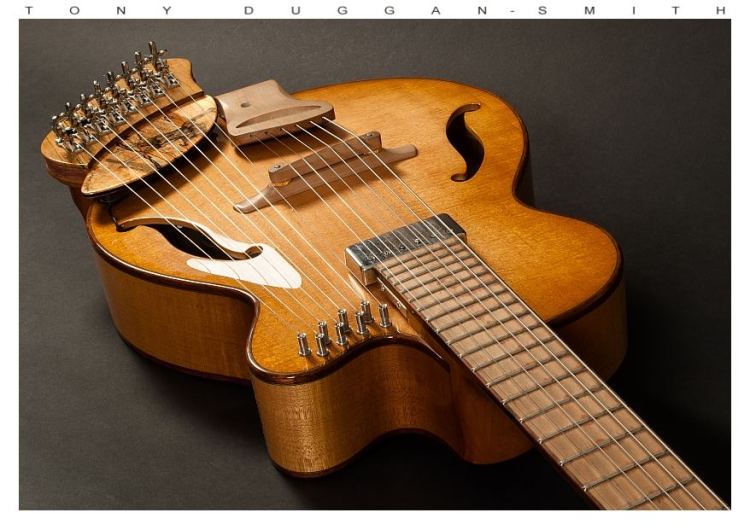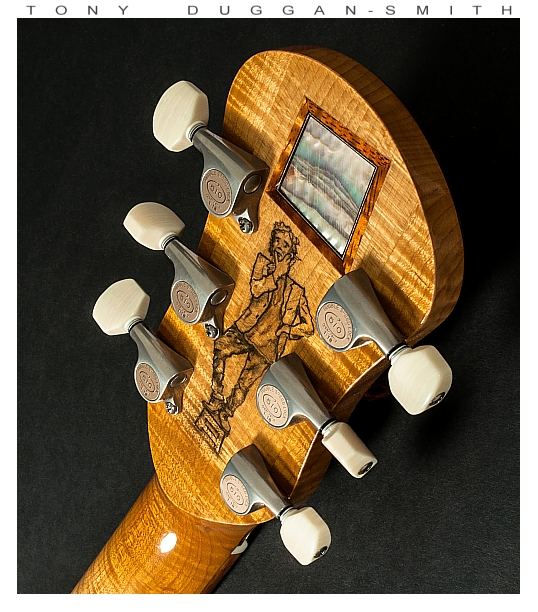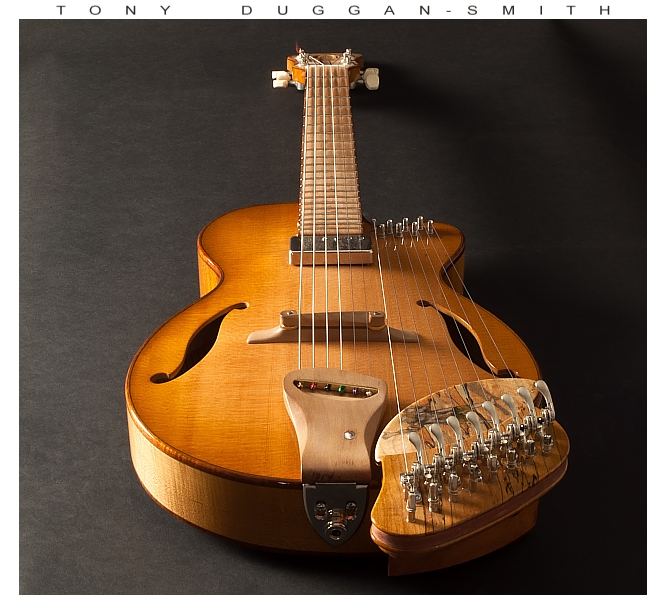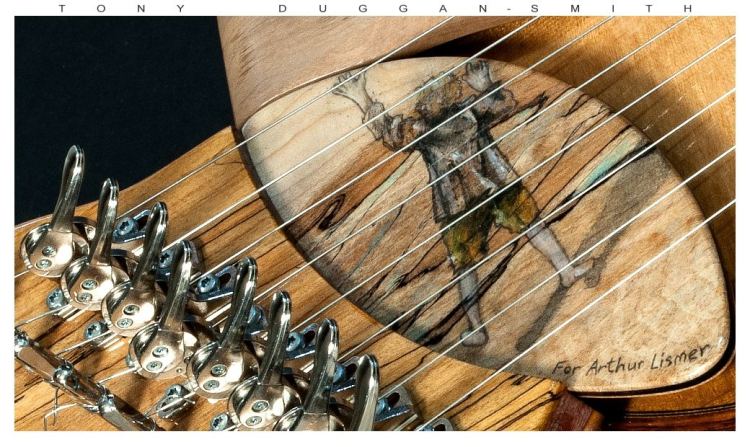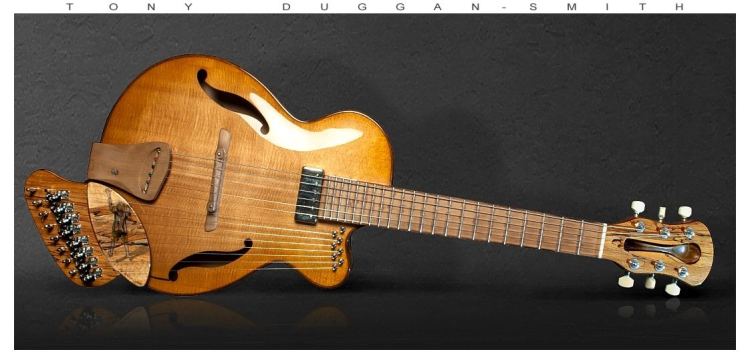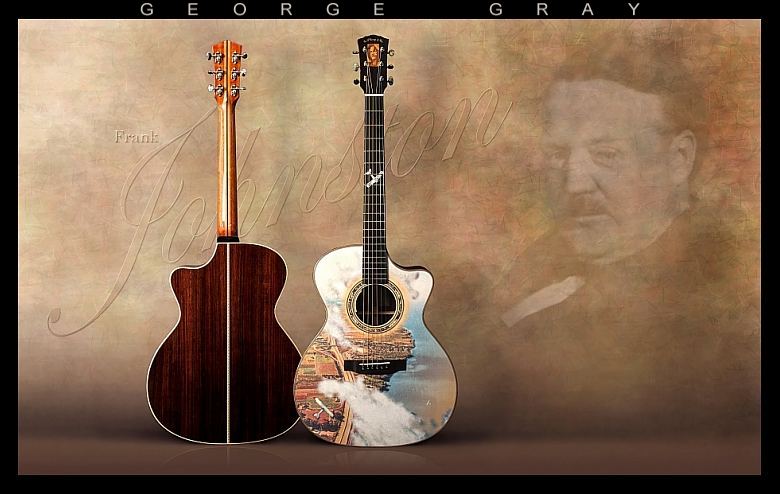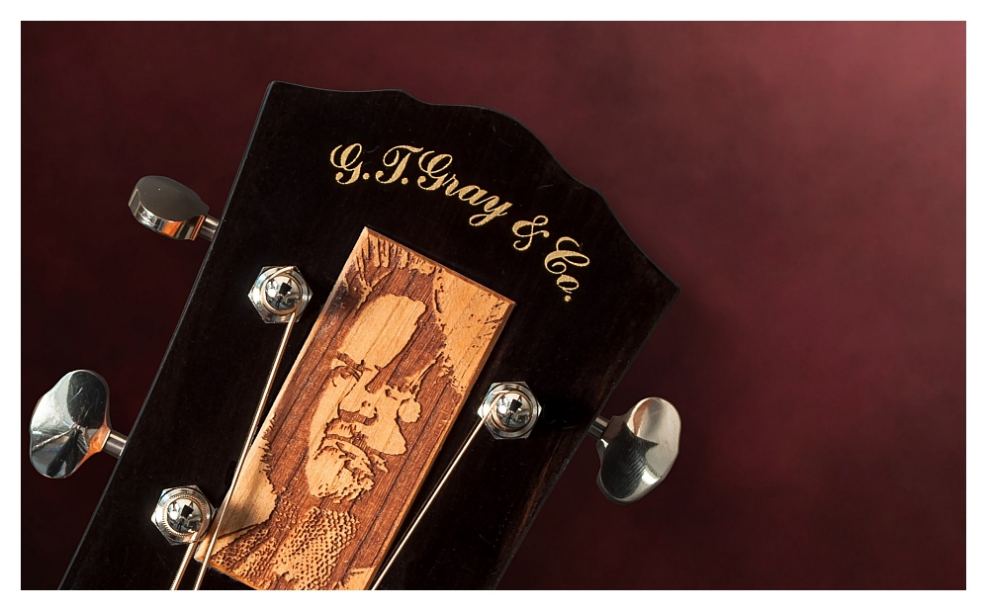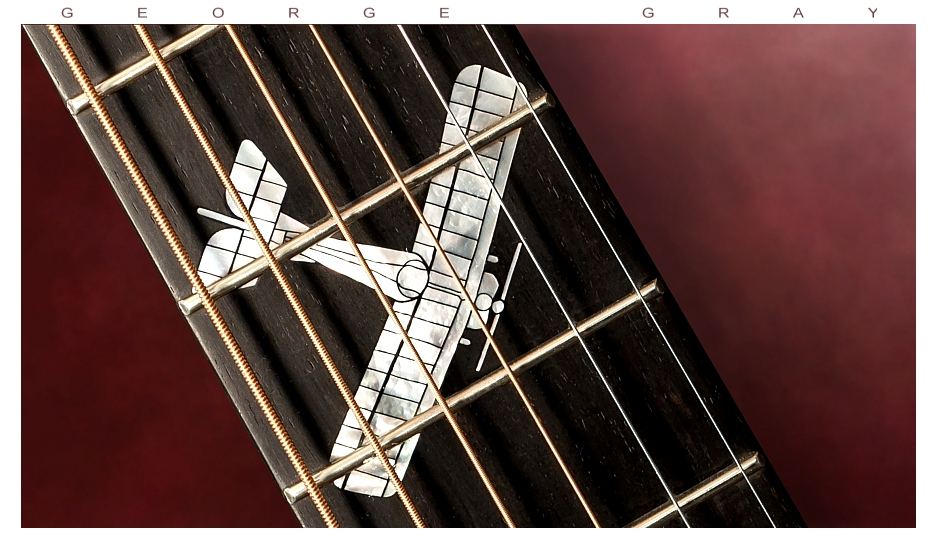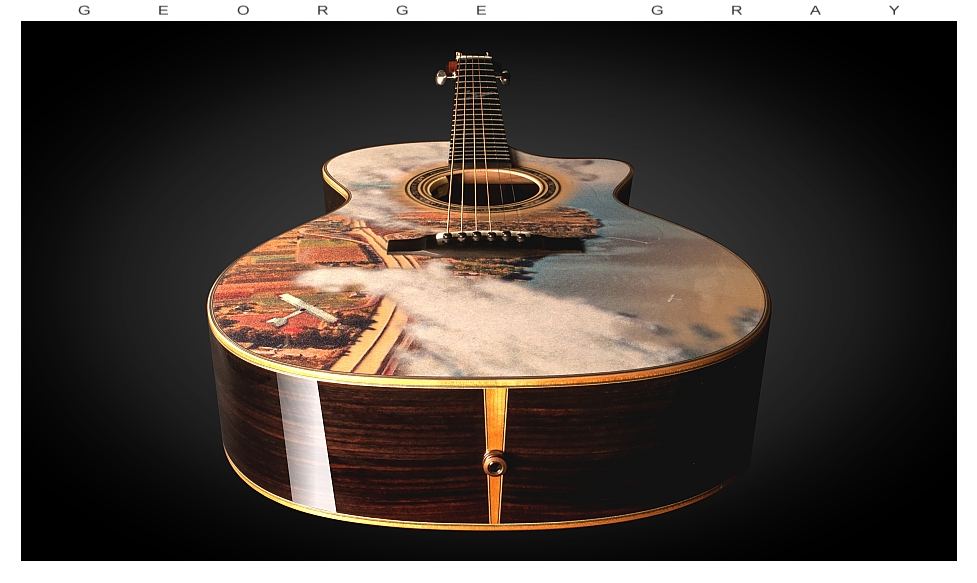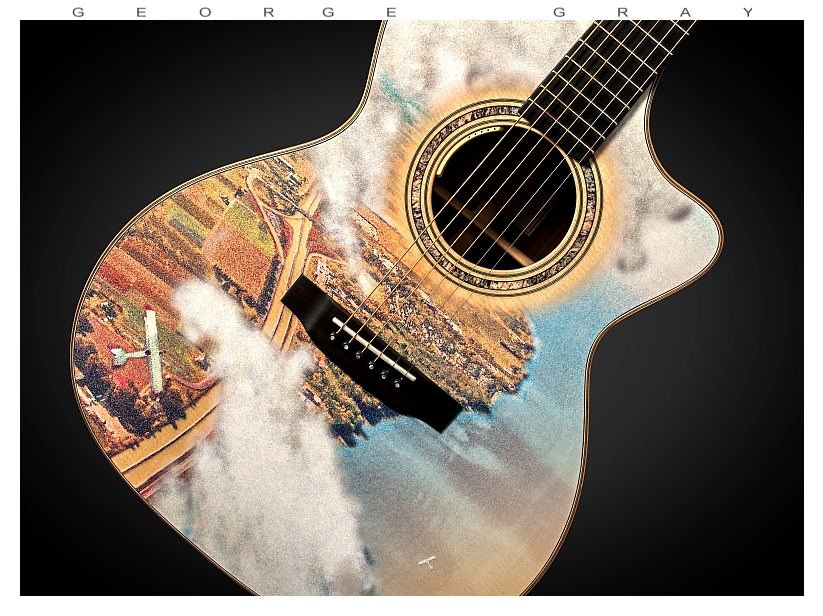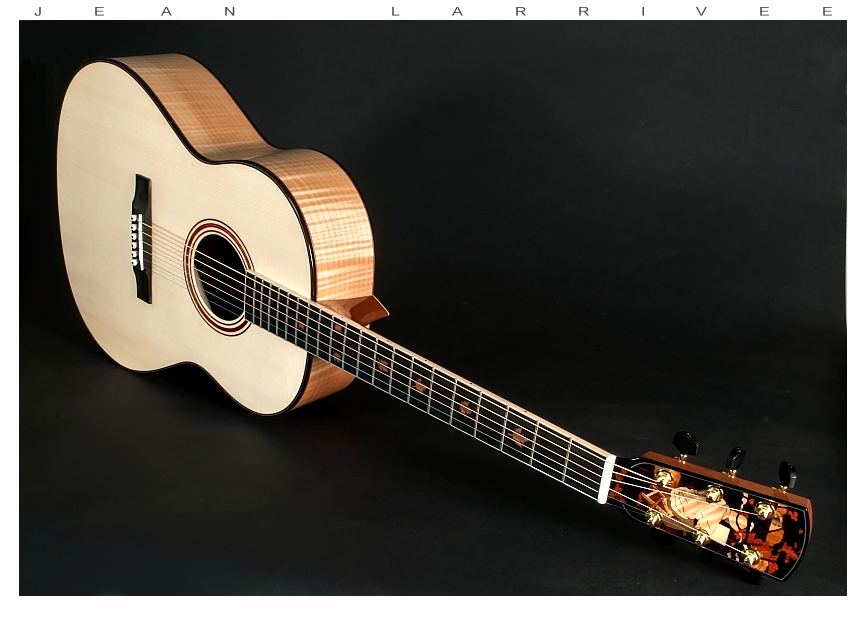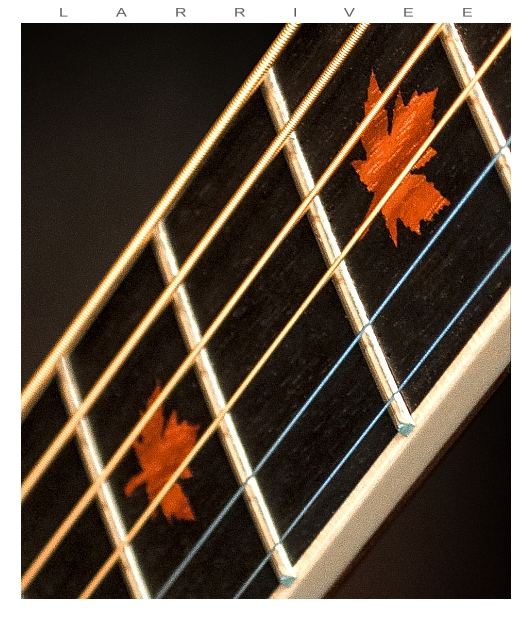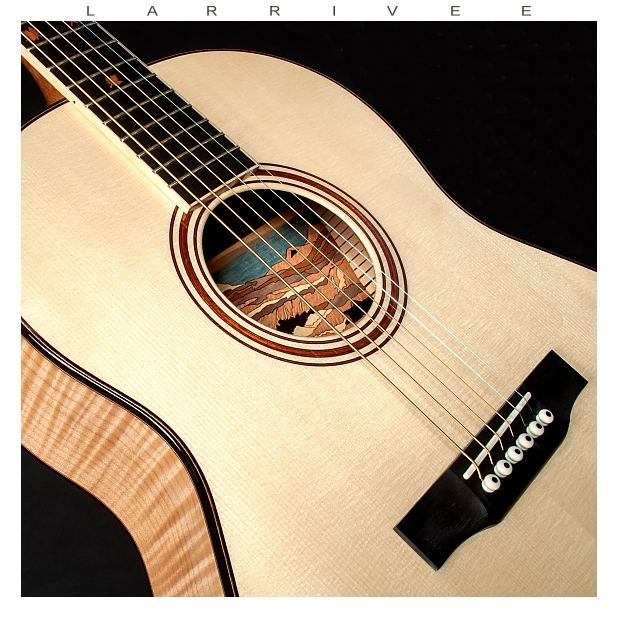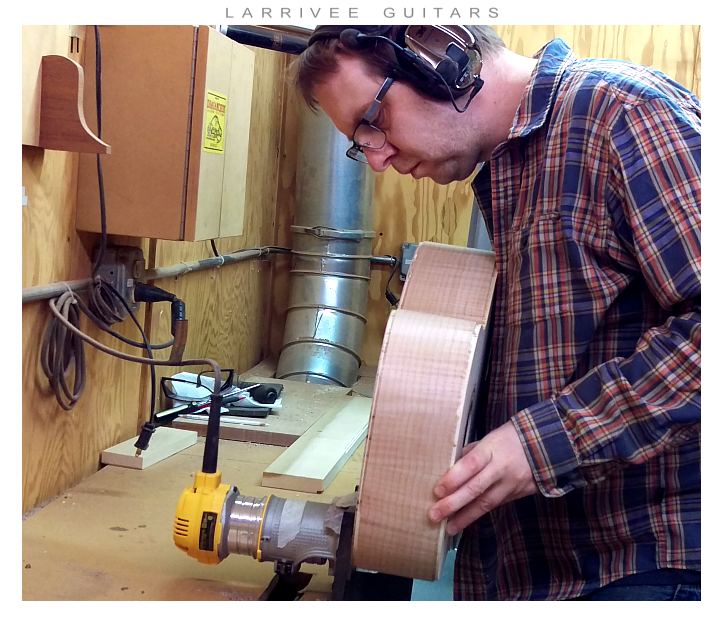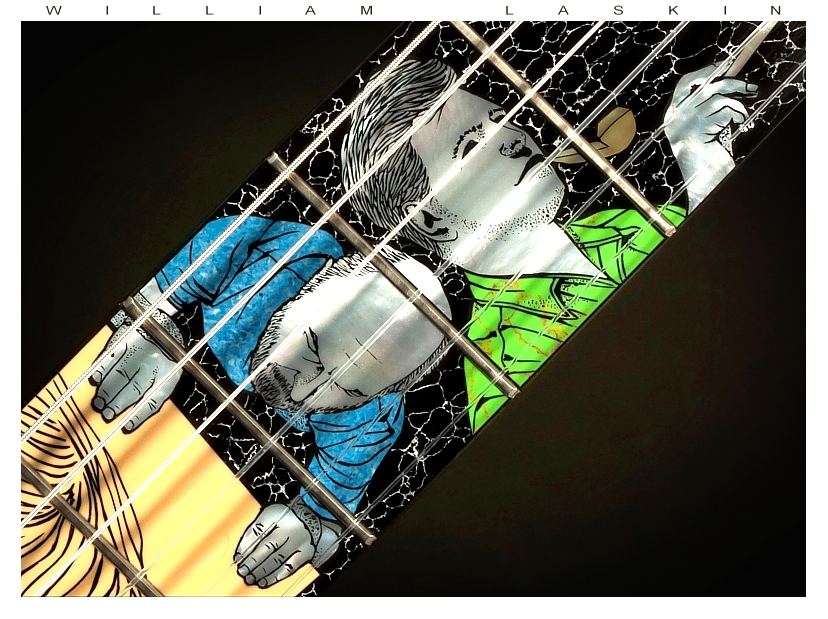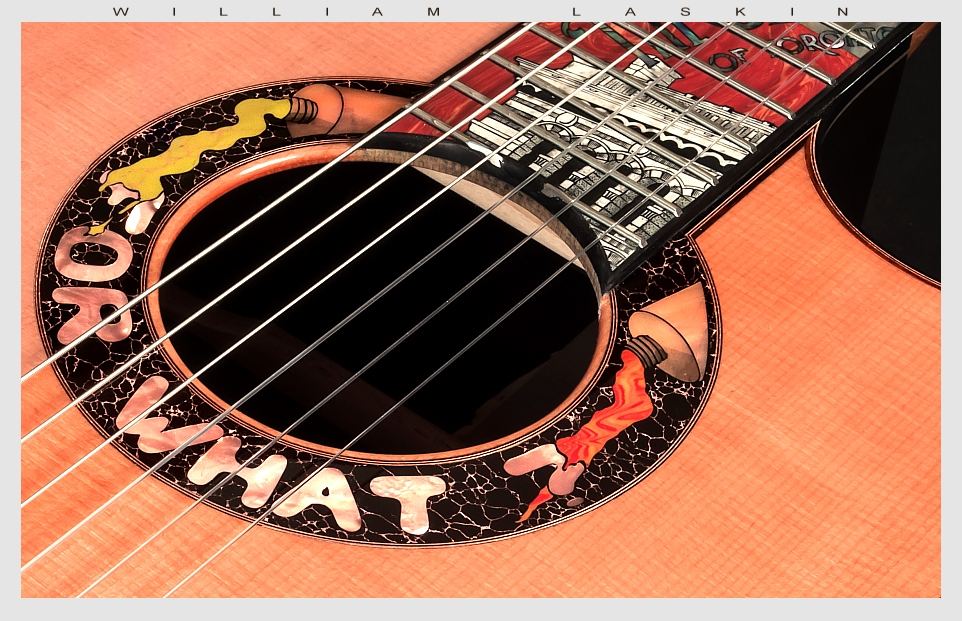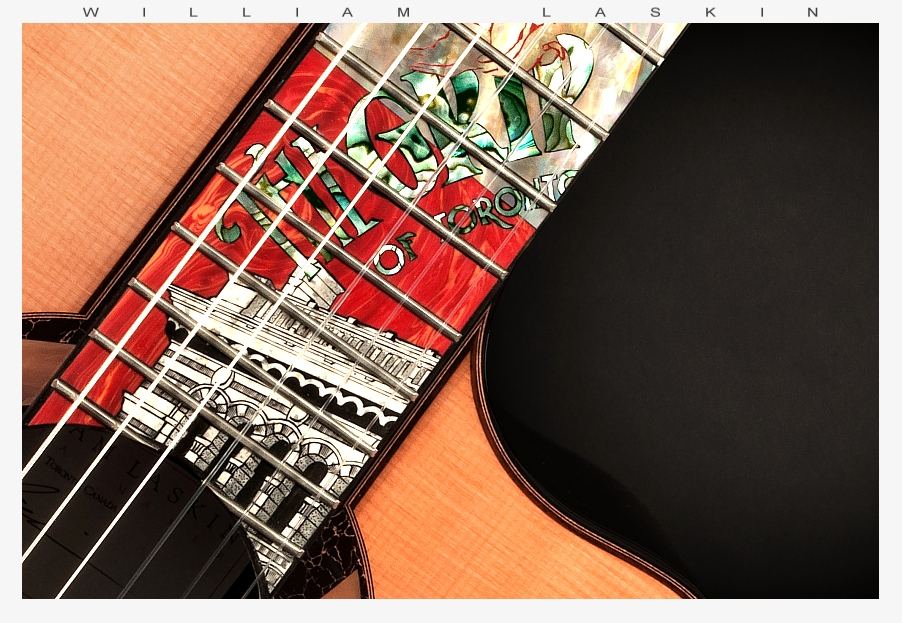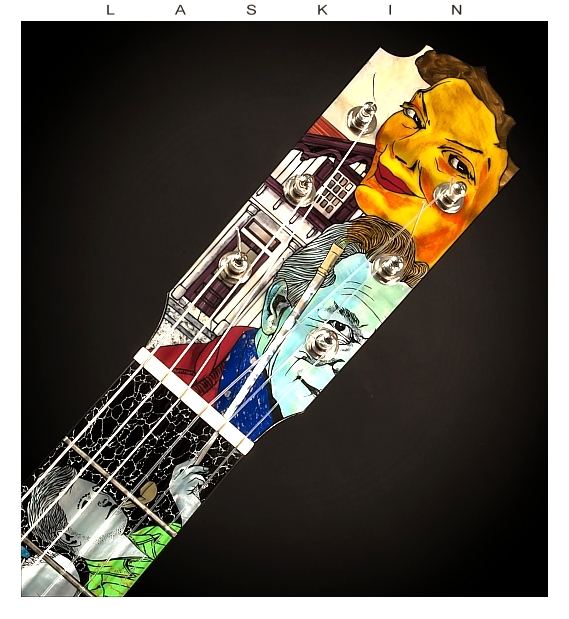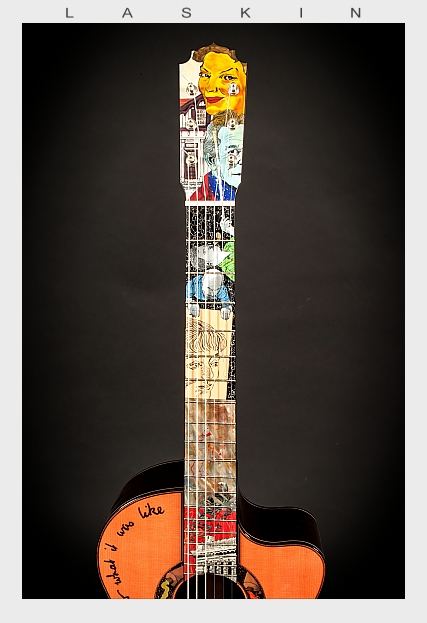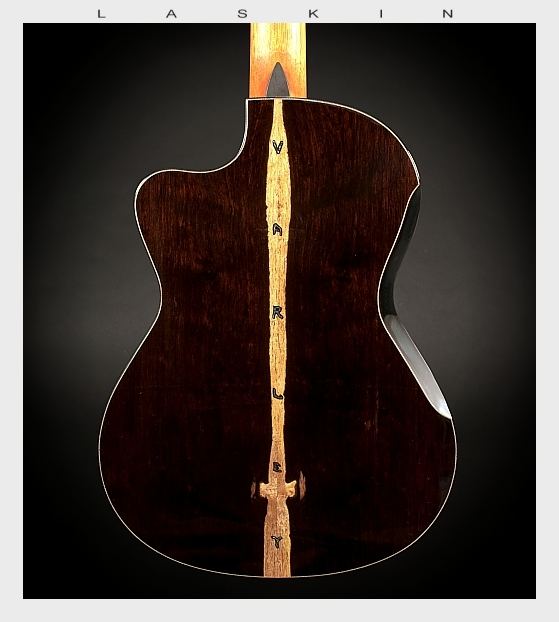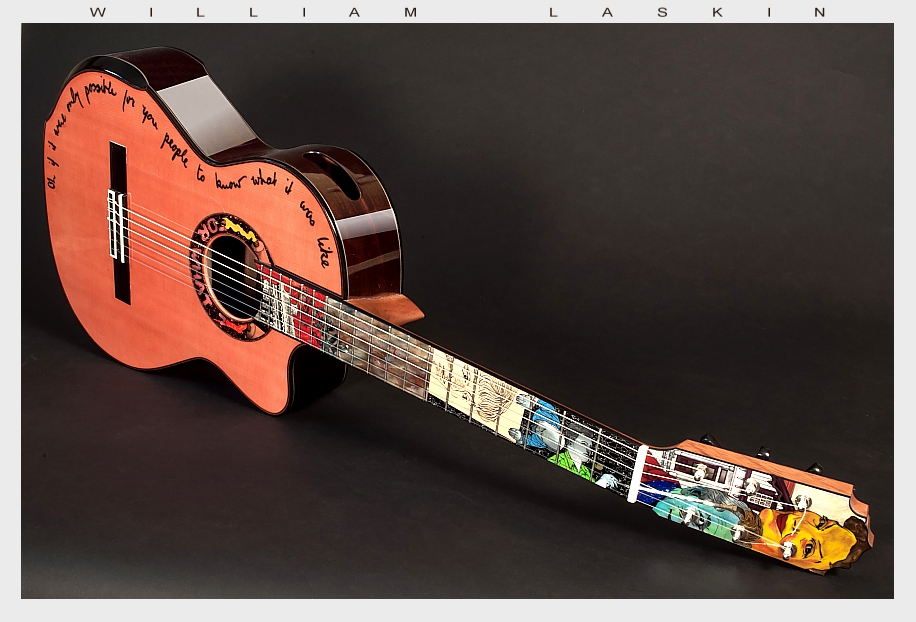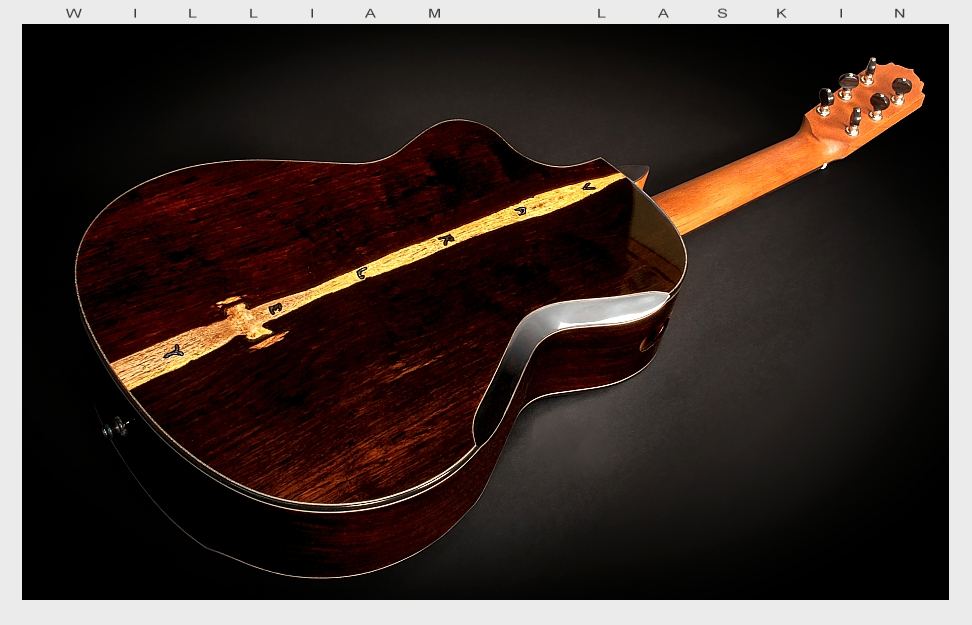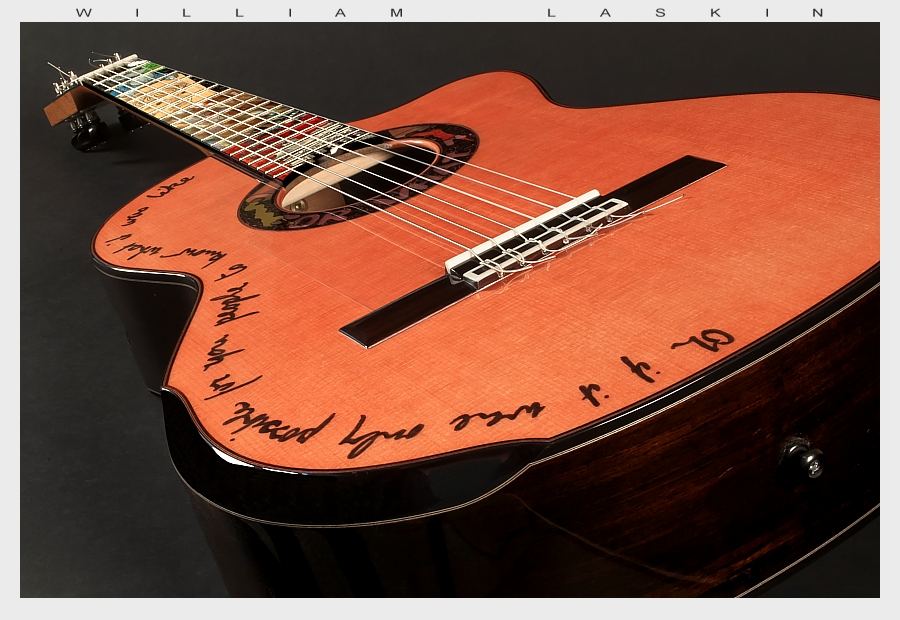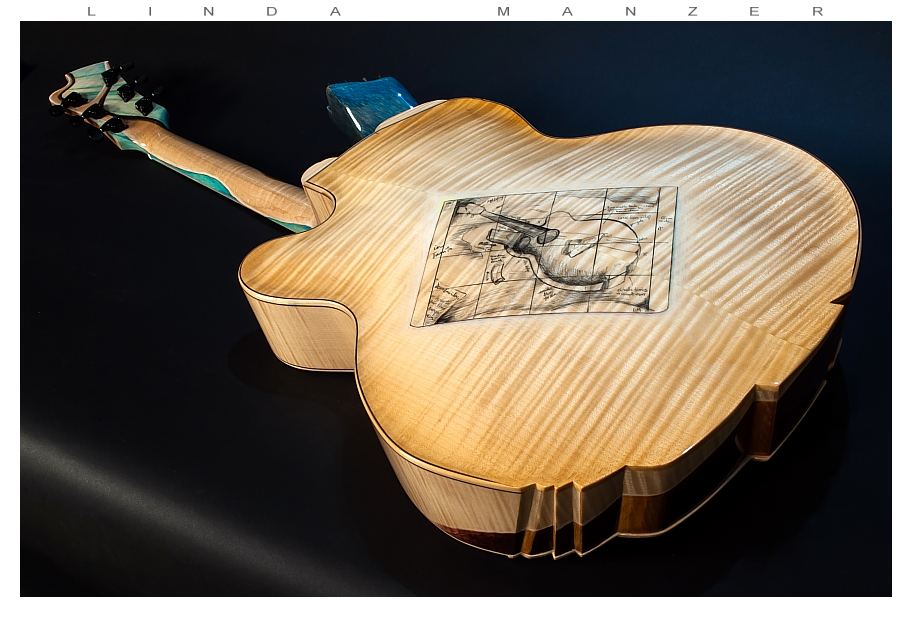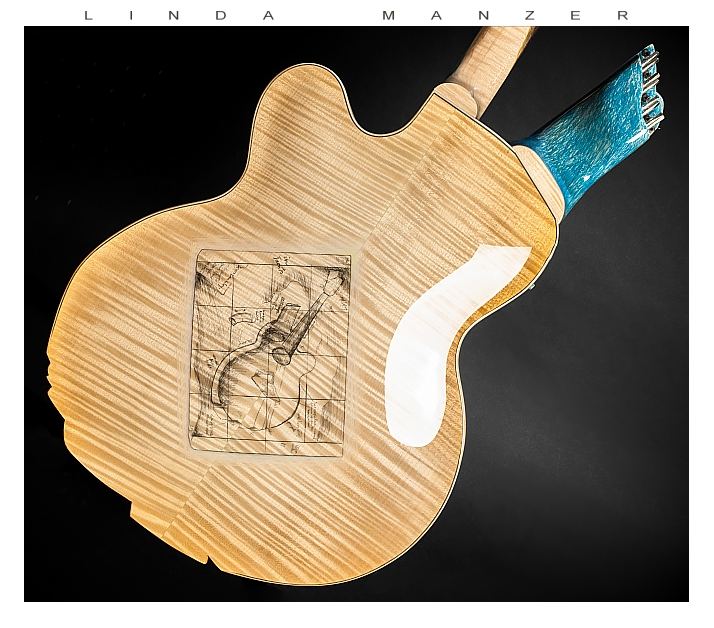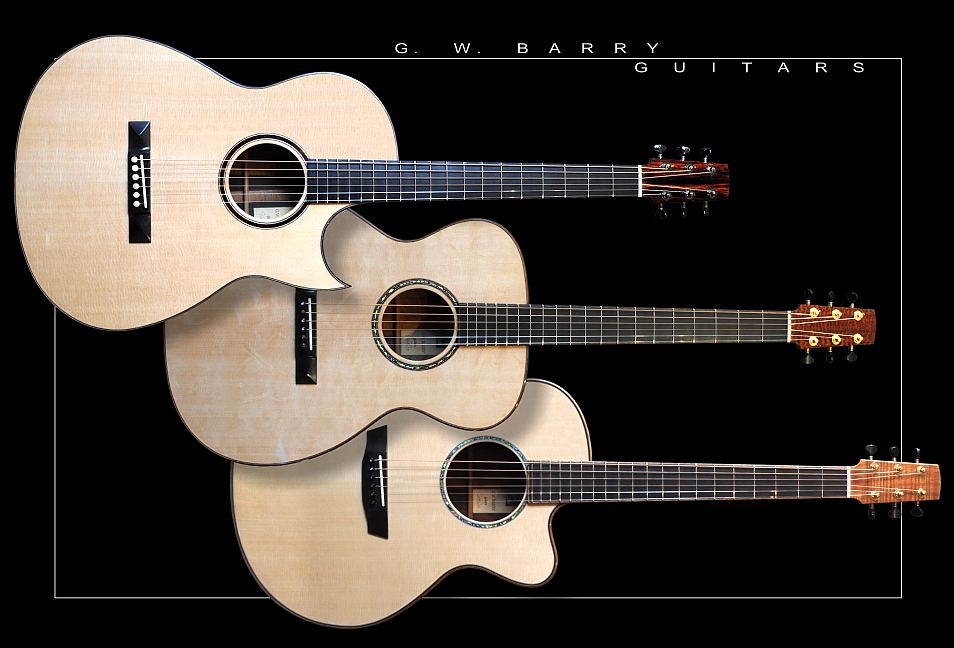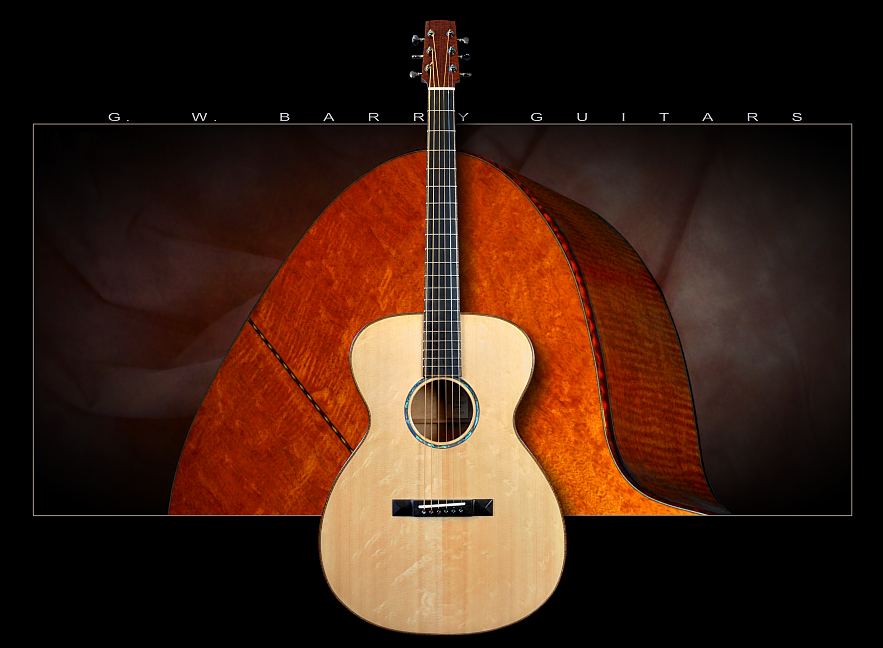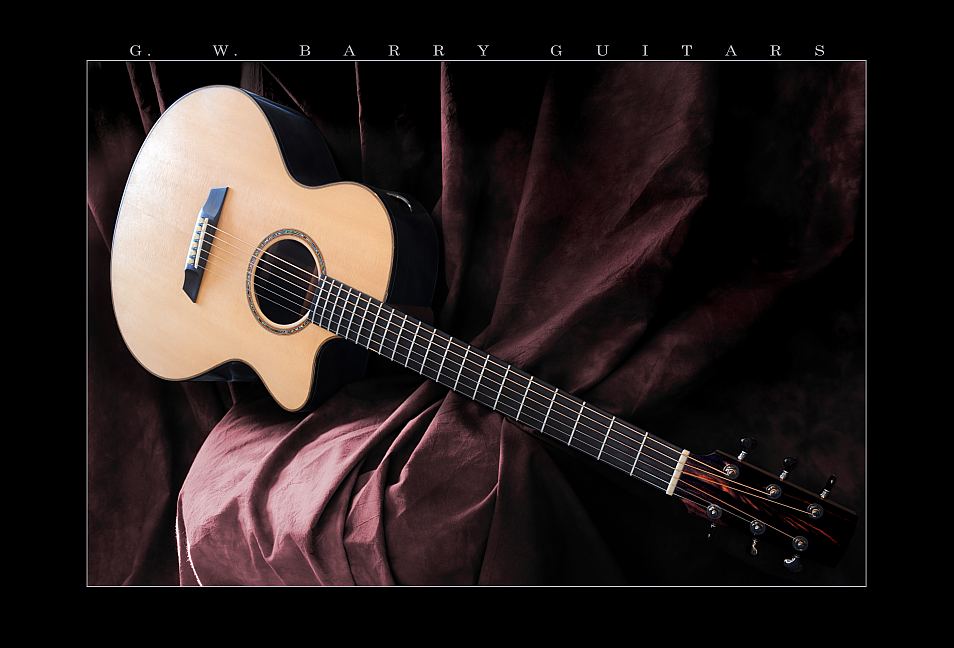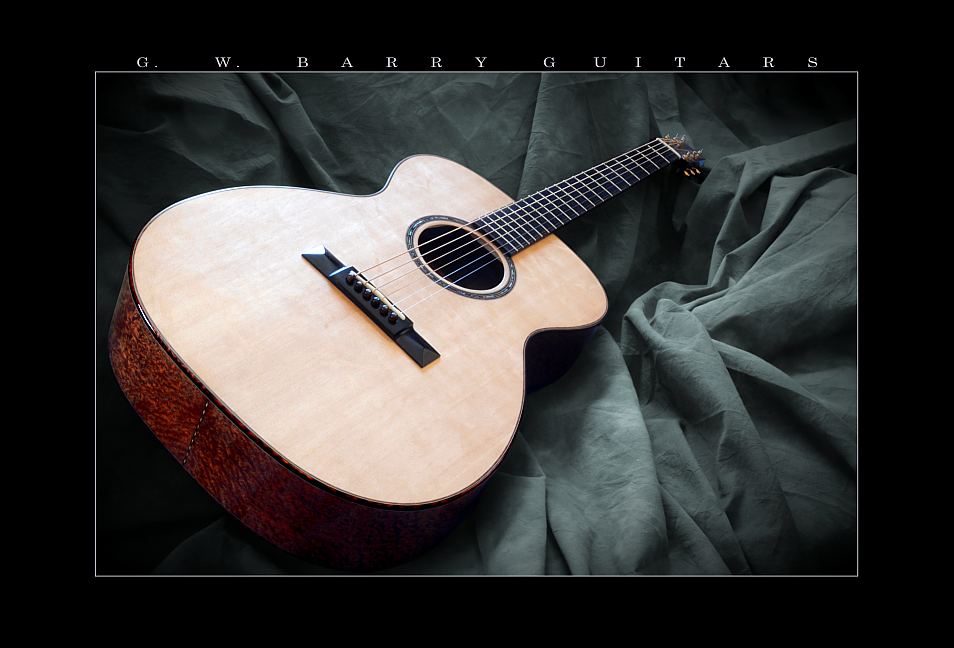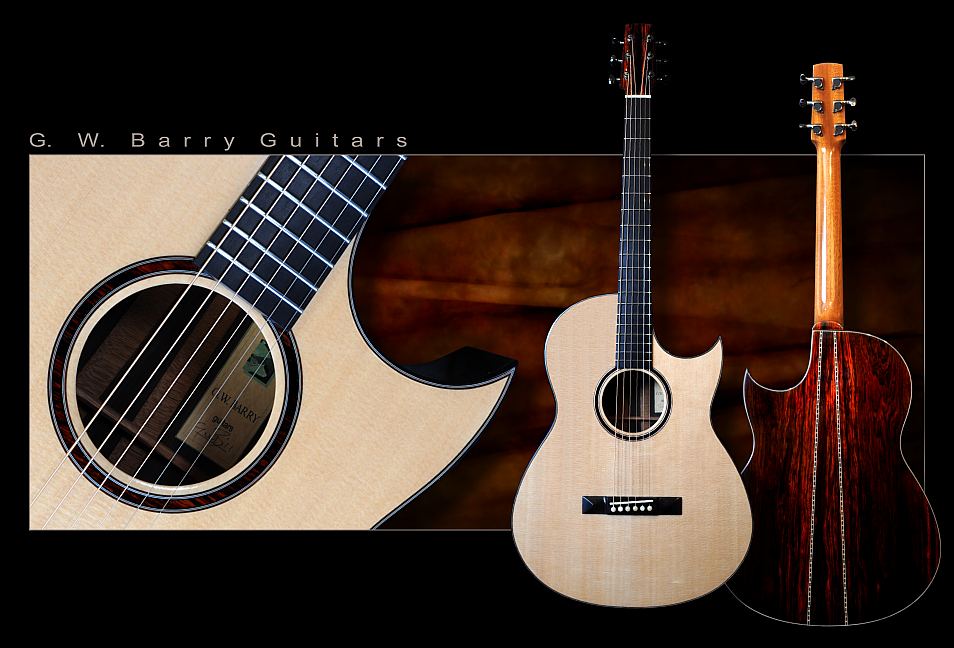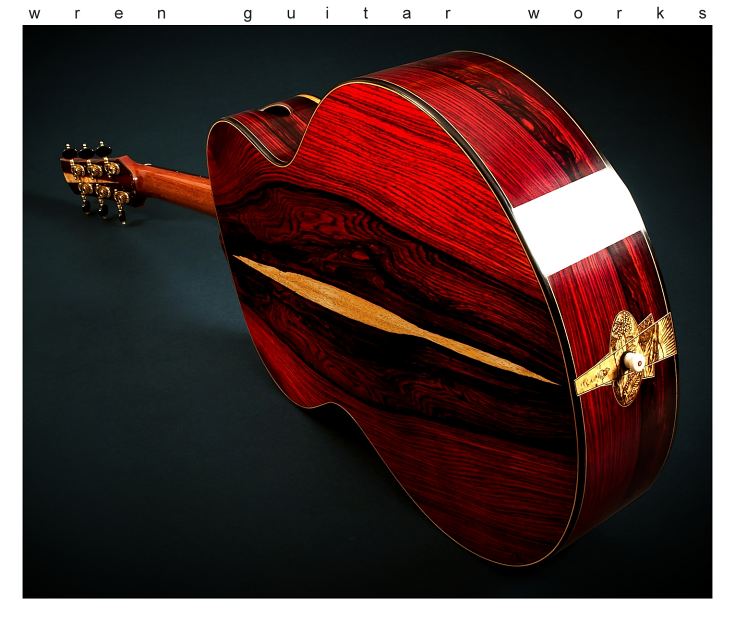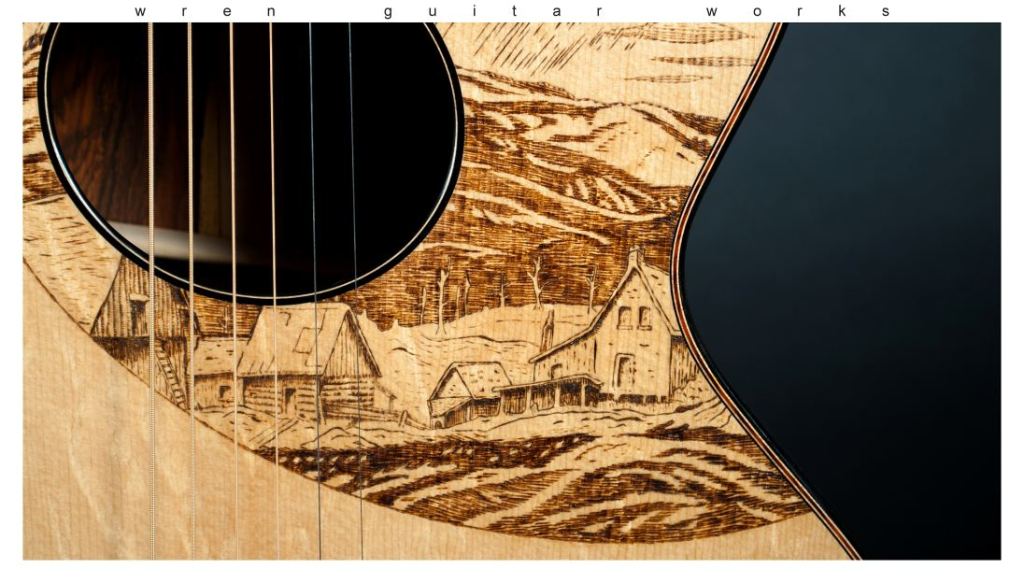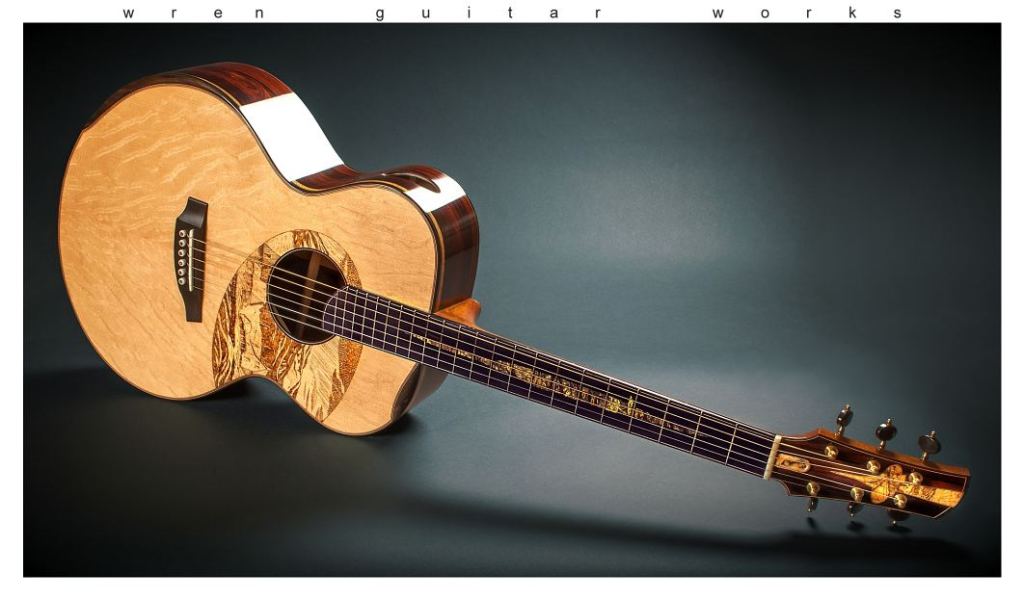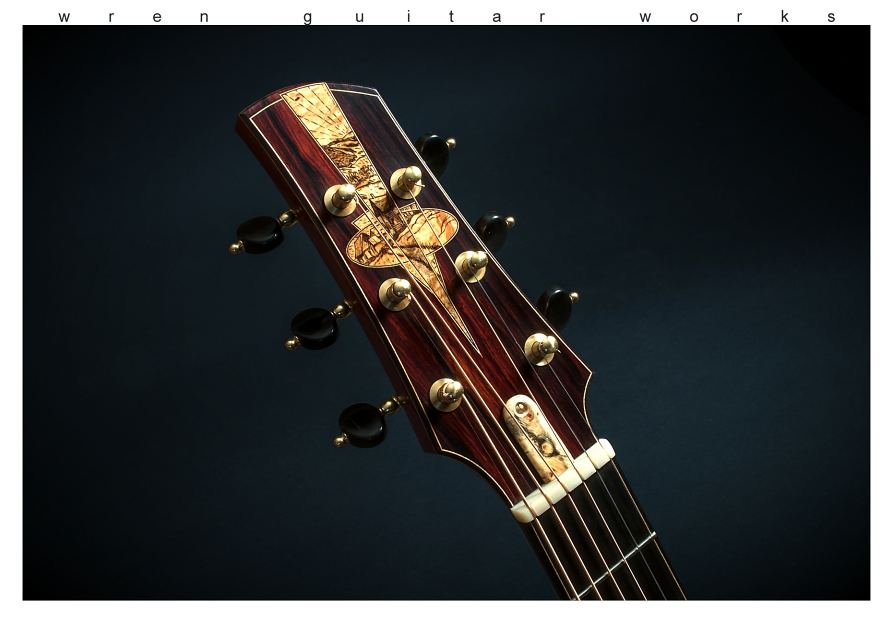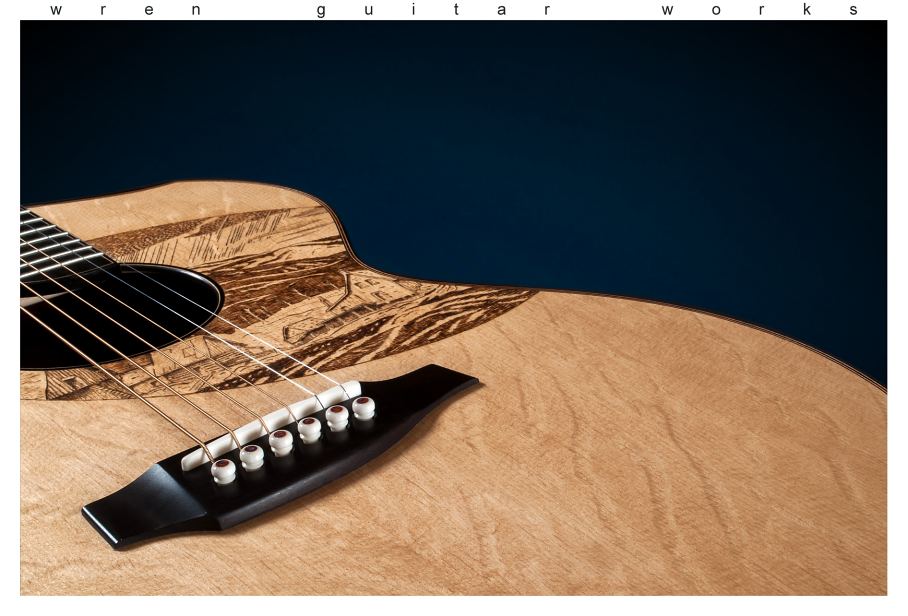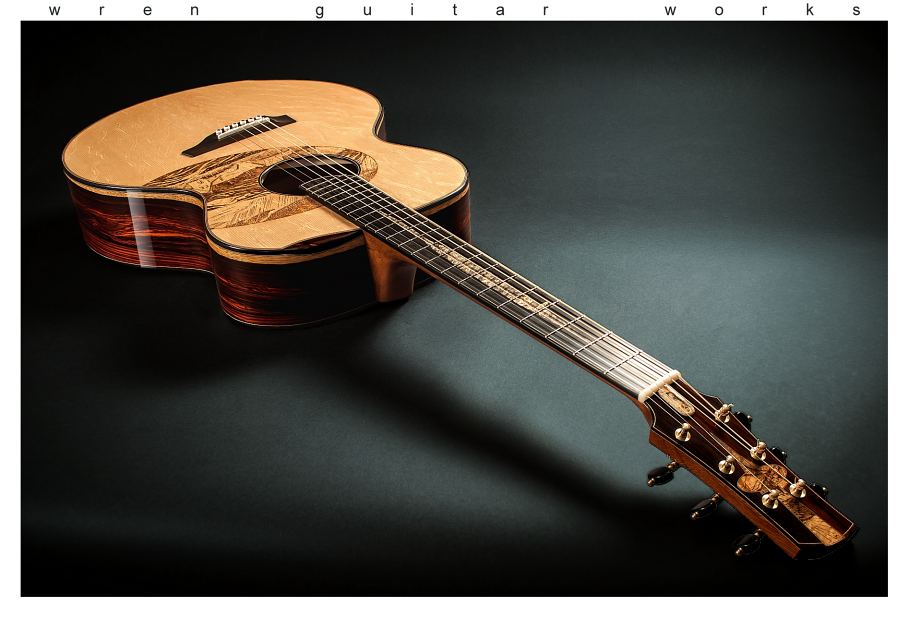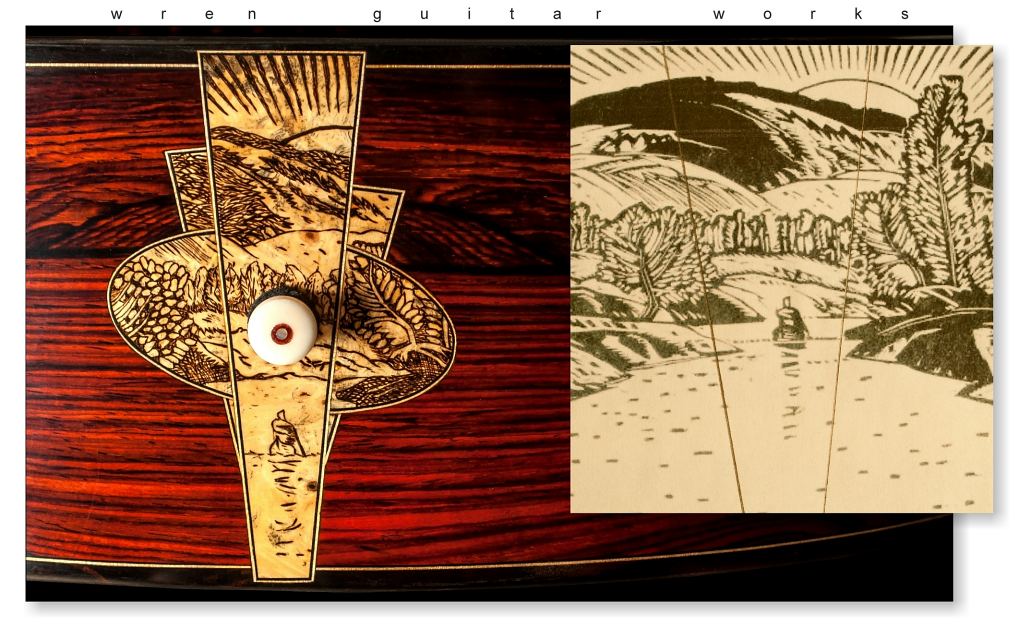

ack in 2012 I remember hearing through the grapevine that Linda Manzer had an idea about partnering with a gallery to assemble a show that compared Jean Larrivee and some of his first apprentices with the original Group of Seven artists. To this end, she contacted luthiers Sergei de Jonge, Tony Duggan-Smith, George Gray, William Laskin, David Wren. and of course Jean himself. Linda’s “outside the box” thinking and her legendary tenacity were definitely the driving force of what ultimately became this amazing project!

The original Group of Seven was officially formed in 1920 and with the notable exception of our rich heritage of indigenous art, their “Algonquin School” of painting was the first distinctly Canadian style. Before this collective was formed, if you said the words “Canadian art”, you would be hard pressed to bring an image to mind. After the success of these iconic painters, all of Canada would visualize wind swept landscapes rendered in a bold and unique style.
In a similar vein, before Jean Larrivée and his early apprentices, if you said the words “Canadian guitar”, you’d be hard pressed to come up with an image. After Jean … you could conjure images of tight waisted instruments with classical influenced mosaic rosettes, clear pickguards and later, side ports, arm bevels and wedged bodies. Most of these features are evident throughout our profession today, but back in the seventies and early eighties, they often represented the Canadian lineage of luthiers.
The guitar building community also has a comraderie similar to these early painters … each builder being supportive and inspirational to the other. I think this may be where Linda really saw a parallel between these two seemingly different worlds.
In any event, Linda decided to initiate meetings with some of the early Larrivée apprentices to knock around ideas. The basic concept was that we’d each build a guitar that was inspired by and payed tribute to one of the original Group Of Seven artists. We’d meet in coffee shops and bat around ideas that at the time I thought were ambitious to say the least. Linda felt the project should include an installation at a major art gallery and a feature length documentary film. I didn’t think the whole thing had a chance of getting off the ground but it was a hoot getting together with the old gang and having lots of laughs!
Well … never underestimate Linda Manzer. The Group of Seven Guitar Project ultimately opened at the prestigious McMichael Canadian Art Collection and was a huge success! The documentary “The Group of Seven Guitar Project” by award winning Riddle Films premiered at the Bell/TIFF Lightbox Theatre, was shown nation wide at Cineplex locations, was shown nation wide on CBC television as well as PBS and played the Hot Docs cinema in Toronto!

Tony Dugggan-Smith, Linda Manzer, Sergei deJonge, Jean Larrivée, William Laskin, David Wren, George Gray
I’d like to offer a huge thank you to Jean for teaching me everything I know about guitar building … and Linda for including me in this amazing project. It was great to have the chance to really stretch myself professionally and just so much fun to get back together with the old gang!

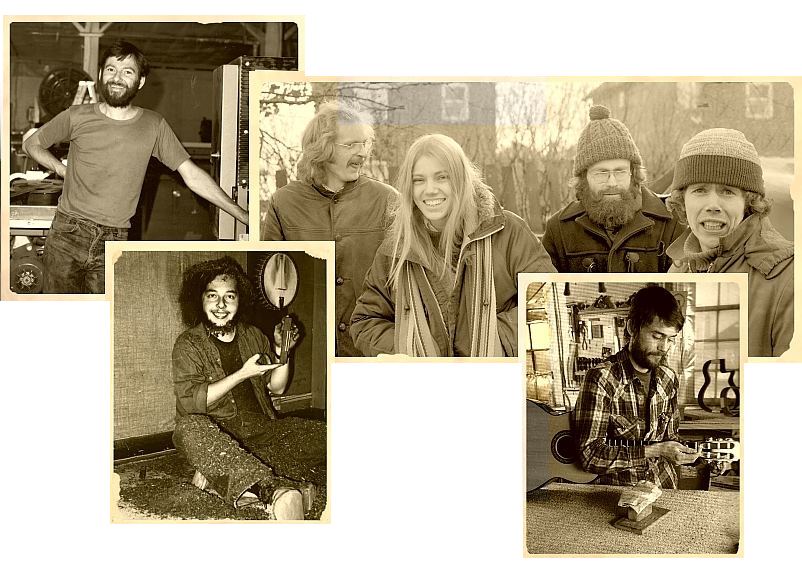
Jean Larrivée, William Laskin, George Gray, Linda Manzer, David Wren, Sergei deJonge, Tony Duggan-Smith
The Group of Seven Artists
The original Group of Seven artists formed in 1920 and consisted of A.Y. Jackson, Frederick Varley, Frank Johnston, Arthurs Lismer, Lawren Harris, Franklin Carmichael and J.E.H. MacDonald. Tom Thomson died three years before the group was officially formed, but was part of this supportive collection of painters and an obvious influence. Believing that a distinct Canadian art could be developed through direct contact with nature,the Group of Seven is best known for its paintings inspired by the Canadian landscape, and initiated the first major Canadian national art movement.
Below is just a random example from each of the original members, plus Tom Thomson.

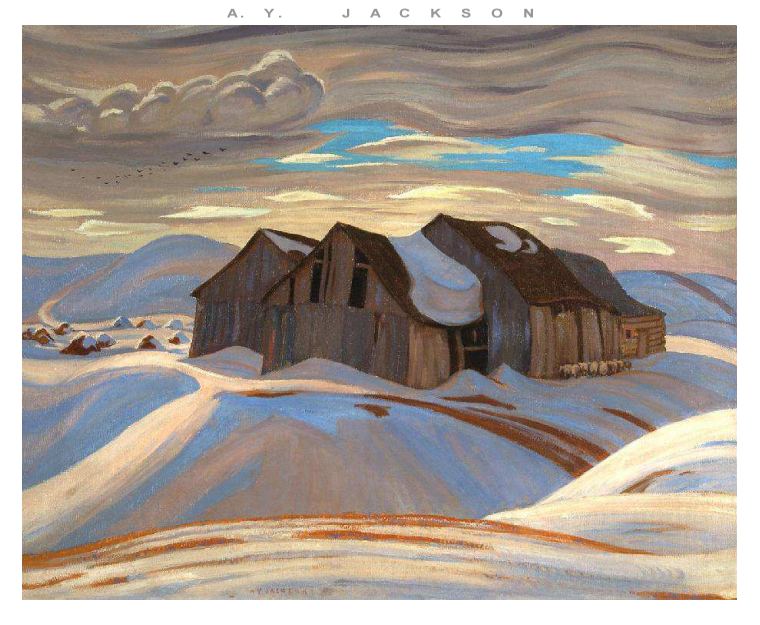
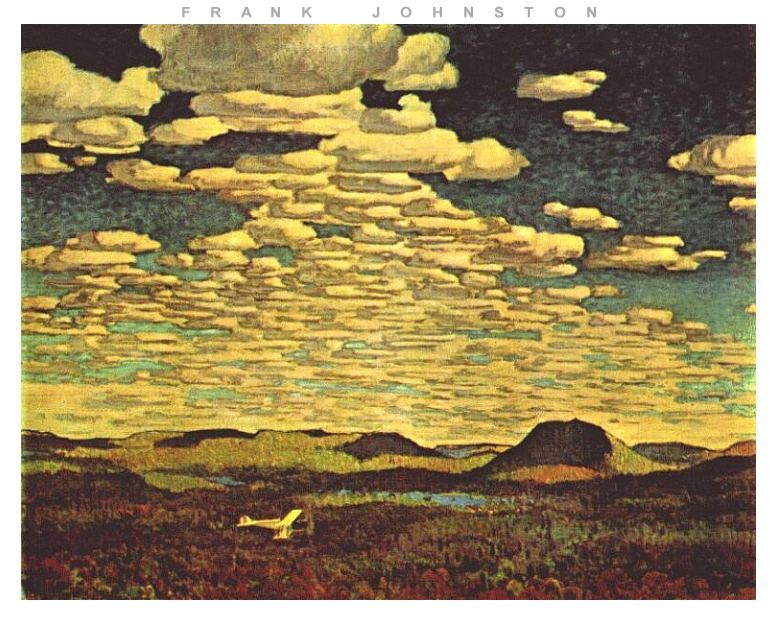

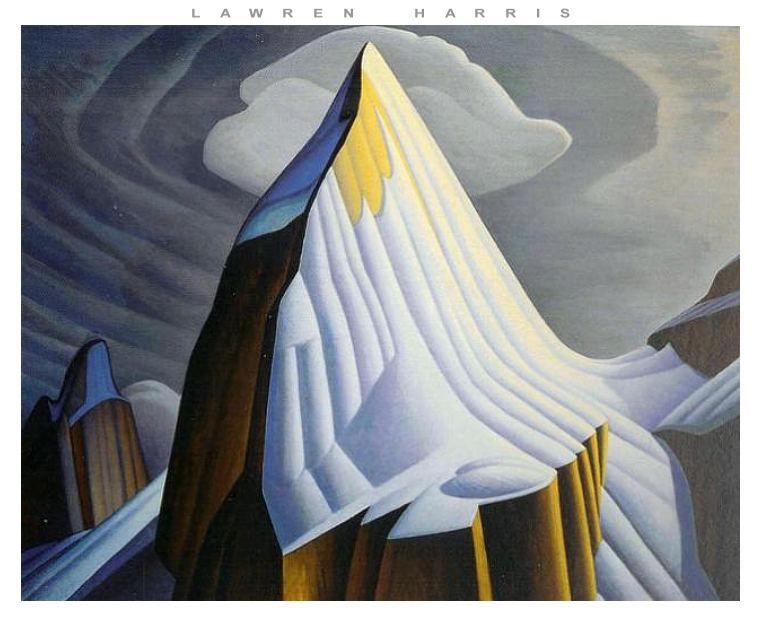

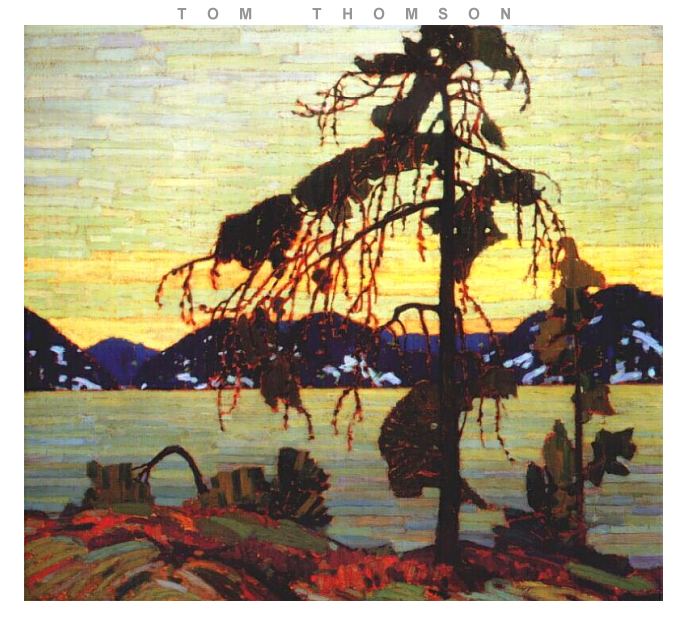
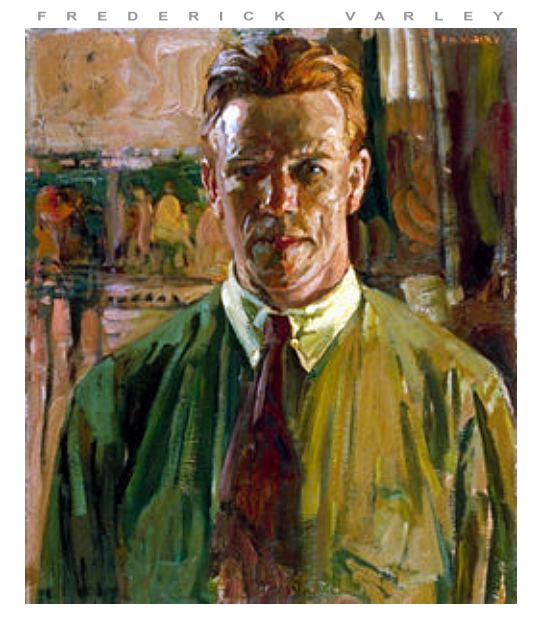
Sergei de Jonge
Sergei de Jonge is one of the most respected luthiers of our generation and he definitely out-did himself with regards to his contribution to the Group of Seven Guitar Project. Here is Sergei’s explanation of his contribution to the Group of Seven Guitar Project

“I wanted to reflect the areas in which he had worked and painted. He did a fair bit of painting right around where I live on the Gatineau River – probably a few hundred yards from our house, for that matter. The guitar is a fairly traditional classical model. The outside is birch bark, which I’ve never used. Of course, a guitar isn’t much good if it doesn’t sound really good. I think I accomplished that.
The birch bark is laminated to maple back and sides—the maple is from Ontario, the birch bark from BC. Liners are Local Eastern white cedar, neck, bridge and binding are ontario Cherry , fingerboards is local ironwood, top is red spruce from Nova Scotia. Walnut purling is Ontario walnut, Rosette is Ontario maple.”
Press
Well … the Group of Seven Guitar Project was launched at the McMichael Canadian Art Collection on May 6th and will run until October 31st 2017(note: it was so successful, that they extended the run to March 18th 2018). There were an estimated 500 people at the opening which is apparently a record for the gallery! This project was conceived and directed by Linda Manzer and included works by Jean Larrivée, Sergei de Jonge, Tony Duggan-Smith, George Gray, William Grit Laskin, Linda Manzer and myself … each luthier creating an instrument that was a tribute to one of the original Group of Seven painters.
Leading up to the opening of the exhibit, we received great press coverage, including two articles in Canada’s national newspaper the Globe and Mail (both online and in print), a write-up in the National Post, a nice piece in Acoustic Guitar Magazine (again online and print), a podcast by Fretboard Journal and an interview on CBC radio’s “q” by Tom Power!
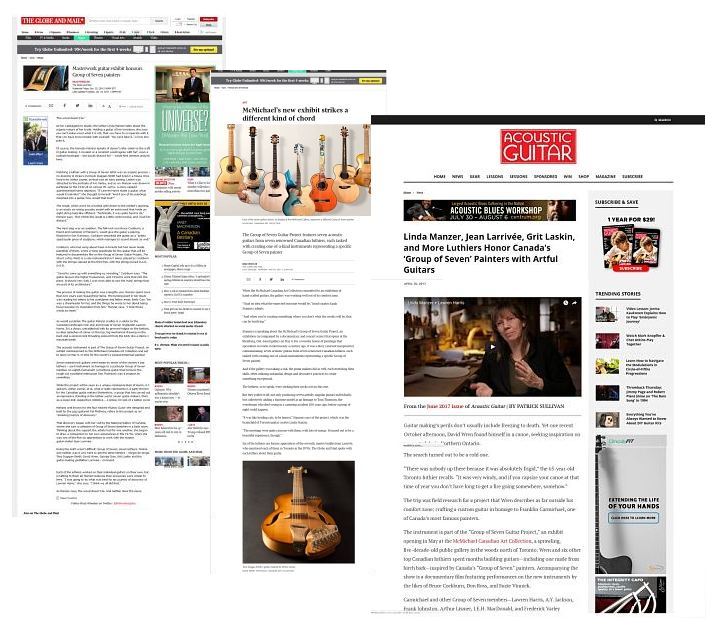
Link to the Acoustic Guitar Magazine Article
Link to the Globe and Mail Article
Link to the National Post Article
Link to the Fretboard Journal Podcast (Number 144)
Listen to Interview on CBC Radio “Q”
The Tom Thomson Guitar
Well, I figured it would be a blast, but I didn’t count on it being quite that much fun!
As part of the “Group of Seven Guitar Project” that is exhibited at the McMichael Canadian Art Collection … all seven of us have been involved in group-building the Tom Thomson guitar. To kick things off, five of us got the woodworking started up in Chelsea Quebec at Sergei de Jonge’s (wonderful) shop.
By the time this instrument was finished, Sergei deJonge, Tony Duggan-Smith, George Gray, William “Grit” Laskin, Jean Larrivee, Linda Manzer and myself were all involved in this guitar.
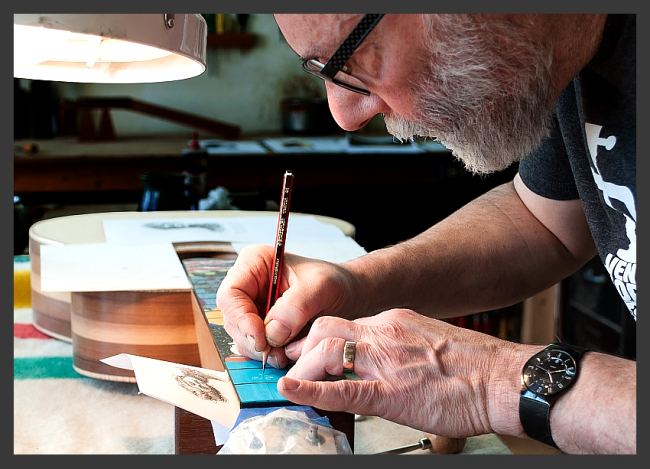
What a great time we had at the McMichael Canadian Art Collection in Kleinburg with another sold out “Acoustic Conversation” … this time focusing on the Tom Thomson Guitar!
This instrument is part of the Group of Seven Guitar Project (Tom died before the original Group of Seven formed but was of course, a huge influence and unofficially the eighth member). The guitar was made collectively by the participants … Sergei de Jonge, Tony Duggan-Smith, George Gray, Jean Larrivée, William “Grit” Laskin, Linda Manzer and myself.
I can’t remember who came up with the “empty canoe” visual theme of the instrument, but it seems appropriate considering the life and mysterious death of this iconic Canadian artist. The wood burned canoe on the peghead along with the cedar strip back and sides, as well as Tom Thomson inspired inlay work and water colour renderings, all add up to create a unique musical instrument!
Getting back together and working with the old Larrivée crew from the ’70s was the highlight of this entire project for us all … what a blast we had making this guitar!
The afternoon was capped off by a wonderful concert on the Tom Thomson guitar by none other than Stephen Fearing! What a treat to hear this instrument put through its paces by such a gifted musician!
The Documentary

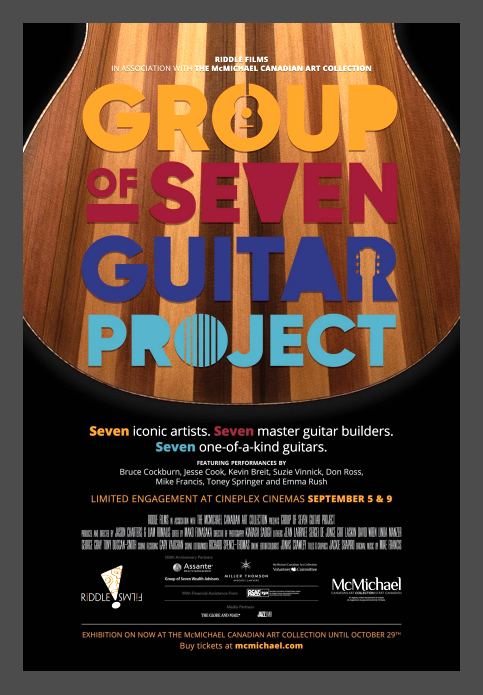
Two days after the opening of the Group of Seven Guitar Project at the McMichael, the documentary by Riddle Films was premiered at the TIFF/Bell Lightbox Theater in downtown Toronto. It was a bit bizarre seeing this project take shape on that large screen! We’ve just heard that PBS has picked up this film and will be airing it in August and that Cineplex will be releasing it nation-wide in conjunction with a special series celebrating Canada’s 150th birthday!

In addition, Jason Charters, Liam Romalis and all of the talented folks at Riddle Films have produced a DVD of this project. The production values are wonderful and their creativity is in full evidence with regards to content and editiing … kudos to all concerned!
Anyone who would like a copy of this, complete with a very nifty booklet … drop us an email and we’ll get you hooked up.
Tony Duggan-Smith
It was no surprise to anyone that Tony Duggan-Smith came up with one of the most unique instruments of the Group of Seven Guitar Project! Here’s what Tony had to say about his creative process.

“My connection to Arthur Lismer mostly revolved around the immediacy of Lismer’s drawings and the fact that he had been the principal of the Victoria School of Art in Halifax to which I had gone in the early seventies under it’s more recent incarnation, NSCAD. In fact the old spoon inlaid in the peghead is a memento from those days and tied to the history of the college itself! A ‘rosebud’ so to speak. Material and design choices were also tied to the period of the painters as a means of meeting halfway.”
The custom case was a collaboration between Tony and Mark Kett. Mark is known by many for his incredible inlay work, but believe me, this gent can do ANYTHING he puts his mind to. This is a carbon fiber case … with birch bark bonded to the exterior … luscious leather bindings and hardware and rich velvet plush interior … one of my favorite things of the entire exhibition!!!
The McMichael Canadian Art Collection

I’d like to thank everyone at the McMichael Canadian Art Collection for all of their incredible support on this ambitious project. This was quite a departure from their normal exhibitions and they really stuck their neck out. The show was a huge success, but none of us knew that during the years of planning, research and preparation. It was quite courageous and innovative for the gallery to produce this show and I can’t thank them enough!
Sarah Stanners, Susan Benton, Ian Dejardin, Linda Morita, Anna Stanisz and Alexandra Cousins are just a few of the names that pop into my head … as well as all of the volunteers and the folks in the shop in charge of designing and building the displays … the list just could go on and on!
Link to the McMichael official site to view current exhibits
George Gray
George Gray started playing guitar at the age of thirteen, and by the time he was in his mid-twenties he had developed a love of the acoustic guitar. A chance meeting in early 1976 with Jean Larrivée at a Toronto music store led to a three-year apprenticeship with him in both Toronto and Victoria, B.C. In late 1978, George returned to Ontario and opened his own shop on the outskirts of Toronto in the town of Markham. In the 1990s, his life took an unexpected turn when his father became ill and he was called upon to run the family business. It was during this time that he developed an interest in aviation and acquired his private pilot’s licence. In 2008, George returned to guitar building. The atmosphere of sharing and mutual support that existed among the luthiers of the early days of the Larrivée shop continues to this day.

George created this guitar inspired by the work and life of Frank Johnston. Gray and Jonhston share a passion for flight, and Gray’s guitar incorporates a photograph he took from his own two-seater airplane of the same view Johnson painted his iconic painting “Beamsville”!
The Band

I have NO idea how we got talked into performing at the McMichael gallery’s exclusive ($500.00 a plate) Moonlight Gala fundraiser … but after one rehearsal at Linda’s place, we performed Grit’s song “I’m A Guitarmaker” in front of 700 well-heeled patrons of the arts. I guess the band reunion will be in twenty years?
Jean Larrivée
Jean Larrivee’s unique contribution to the Group of Seven Guitar Project is just what you would think … an exquisite instrument that utilizes stunning figured tonewoods, his classic “Concert” body shape and A.Y. Jackson themed inlay! As beautiful as this work of art is on the outside … the real story for me was the breathtaking marquetry on the interior of the back!!

Wendy Larriveé feels that the painter’s art comes from the inside … an inspiration deep within the artist … so the lion’s share of her graphic representation of A.Y. Jackson’s work is on the inside of the Larrivee guitar … a cool concept! There are literally thousands of pieces that depict four of this iconic painters works on the inside of the back! It is absolutely staggering the amount of creative and innovative thinking that went into this instrument!
Michael Francis
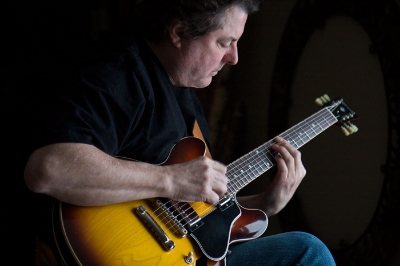
I’d like to send a huge shout out to my buddy Michael Francis! Mike has taken time out from his busy performing and studio schedule to support my part in the Group of Seven Guitar Project. He was not only featured performing in the documentary, but composed and recorded several pieces specifically for the project. Check out “Grace Lake” and “Shadow and Light” if you want a real musical treat. I can’t thank you enough Mike!!!
William “Grit” Laskin
Grit explains his contribution to the Group of Seven Guitar Project the best … here is his artist statement.
Flamenco Guitar response to Frederick Varley
Title: BECAUSE OF CONSTANCE
Artist Statement
Of all the Group Of Seven painters I was drawn to Varley initially because of his portraits, something I too enjoy creating in the medium of Inlay on my guitars. It seemed that he did more portraits than landscapes, which made him somewhat different from the other Group Of Seven members. The more work of his that I viewed the more I observed
his unique use of colours, both the reds and the greens. Especially when the portraits weren’t commissions, when it was solely his choice of subject matter, the colour schemes became very expressionistic—for example, deep red shadows on a face; green/blue hue to skin tone. This too drew me in. I confirmed my observations with the curator of the Varley Gallery in Unionville, Ontario, Anik Glaude, who herself had published a paper on Varley’s colour use. That led me to read the very colour theories, specifically those from Albert Munsell and Wilhelm Ostwald, that influenced Varley.
The third aspect of Varley’s work that captivated me was his experience of War. He was a war artist in the fields of France during the first world war. Seeing the paintings and drawing he did while there, and reading the letters he sent home to his wife Maud, with their private observations, was profoundly moving. His response to the horrors of that
war perhaps summed up in the title of one of his paintings, “For What?”, resonated with my own feelings about violence and conflict.
When I do Engraved Inlay Art on my guitars, I look for the narrative thread (usually based on a theme from my client). It is never simply decoration—I love to tell a story. The narrative on Because Of Constance is a blend of a few pivotal locations and people from Varley’s life, in a loose timeline, blended with my interpretation of a few of his
works that moved me. I too made use of his colour palette, specifically the spirituality of blue/greens and the passion of orange/reds

TEXT ON THE TOP:
“Oh if it were only possible for you people to know what it was like”
This phrase was a direct quote from one of the letters Varley wrote home to Maude from the war fields of France, dated April 28, 1919. The text is written in my reproduction of Varley’s own hasty penmanship. To write directly on the guitar top, and to do it on the bass side, so that it’s readable while in playing position, was inspired by the Iconic
American folksinger Woody Guthrie, who had written his heartfelt political opinion on the guitar he played through the dustbowl depression of the 1930’s and through the years of the second world war. His guitar said: This Machine Kills Fascists. The top has also been given a red-tint, symbolizing the blood-heat of a war zone.
THE NECK AND HEADSTOCK:
1.The story begins at the edge of the soundhole, in the high frets, and moves chronologically toward the headstock. The first element you see is a corner of the School Of Art in Sheffield, England, where Varley first studied.
2. The logo of The Grip, the graphic arts firm that gave Varley his first full-time employment when he newly arrived in Toronto. Equally important, this is where he met the fellow artists who would form the Group Of Seven.
Behind me the younger Varley is in process of painting / creating his elder self. The choices we make while young certainly inform and shape whom we become.
Above the elder Varley is my interpretation of Varley’s “Laughing Cathy”, a painting he finished in 1953, the year I was born. This was a glorious portrait of Kathleen McKay, his companion through the last years of his life, and the house behind them both was the McKay family home in Unionville, Ontario home, where they both lived.
Acoustic Conversations

All seven of the guitar builders hosted their own “Acoustic Conversation” at the McMichael … a moderated discussion about the artistic thought process that went into creating each instrument, and how it related to the artist it was paying tribute to. Part of each event was a concert performed on the guitar being featured, by accomplished Canadian musicians. I was extremely lucky to have producer Kerry Crawford as moderator and renowned studio guitarist Michael Francis in concert!
Moderator Kerry Crawford is a musician and producer who has spent over thirty years in recording studios, working in a production capacity for advertising music, TV shows such as Second City Television, and producing records for noted Canadian artists such as Bruce Cockburn and Jane Siberry. Kerry has enjoyed working with a diverse group of musicians whose venues have ranged from the sidewalk to our finest concert halls. Being a guitarist himself, he has taken a special interest in the evolution of the instrument and is a great admirer of the remarkably talented luthiers participating in the McMichael Canadian Art Collection’s The Group of Seven Guitar Project.
Mike Francis is considered by many to be the most recorded guitar player in Canada. He has spent over 35 years working in the Toronto recording scene on literally thousands of jingles, numerous tv shows, films, and recording projects for variety artists and producers. The various styles he plays include Blues, R+B, Funk, Jazz, Pop, Folk and Country music. He has recorded with Alanis Morissette, Jann Arden, Enrique Iglesias, Anne Murray, Gordon Lightfoot, Nelly Furtado, Kim MItchell, Alannah Myles, Jesse Winchester, Smokey Robinson, and many others.
For my part, I’ll be walking everyone through the creative process of my instrument and commenting on the past, present and future of handmade guitars in Canada, the universe and beyond!

Linda Manzer
Below is an insight into Linda’s creative process for the gorgeous Lawren Harris Guitar!
“Guitar making combines a bunch of different disciplines. Obviously there’s the woodworking aspect of it, but because it’s a musical instrument I have to listen to what I’m doing. It’s also scientific – there’s a functional aspect to it, because you’re putting over 200 pounds of pressure on these skinny little pieces of wood. If you don’t do it right, it’ll explode. There’s a balance between the right amount of wood so that the guitar is sensitive, and it sings, and there’s also the visual aspect. It has to be pretty, and feel good when you wrap your hands around it. That’s crucial.
My original goal with building this guitar was to introduce people to the work of Lawren Harris. What I wasn’t anticipating was the effect this journey would have on my own life. I was deeply moved by his artistic concepts and inspired by him as a person as I discovered more about him. Particularly poignant for me were his letters of encouragement to fellow artist Emily Carr. I spent an afternoon reading his handwritten letters to her from the 1920s and 30s. These letters are not published and it was like walking into a Time Machine. What a great chance to listen in on the conversation between two of Canada’s most revered artists.

When it came time to build a guitar I decided to approach it from the point of view: If Lawren Harris designed and made a guitar what would he do? I knew it would be icy cold like his paintings of the north but I wanted to include some other periods of his work including his early Toronto paintings from the “Ward” period in the 20s and include what I found inspirational – his notebook sketches before he would execute the bigger paintings. I also knew it had to be big and bold and I had to take some chances. His letters to Emily inspired me to dig deep and particularly to trust my intuition. In some ways this was the biggest leap for me. The Group of Seven painters blazed a trail where no Canadian painting group had gone before metaphorically and physically wandering into the wilderness of northern Ontario. So it was easy to be inspired by them. “
Group of 77
I really wish that a project like this could include all of the amazing luthiers who have earned the kind of exposure and recognition that this exhibit provides. There are just so many talented builders in Canada who have come out of the Larrivee tradition, and a good many who have taken a different path as well. The very first that comes to mind is Gordon Barry. G.W. Barry apprenticed and worked with Jean over thirty years ago, and since then has created a body of work that has distinguished him as a world class luthier. Many many other builders come to mind as well … you know who you are. I really wish that it was the Group of Seventy-Seven!
Here’s a great video documenting the time period that G.W. Barry was at Larrivée Guitars!
David Wren
Here are some shots of my contribution to the Group of Seven Guitar Project! I started with a blank sheet on this one and designed it from the ground up as a tribute to the great artist Franklin Carmichael.

The graphic elements are from his prints and sketches and are rendered on the guitar by wood burning. The top is a spectacular Sitka spruce set with dramatic bear-claw figure. The back and sides are Cocobolo with hints of sapwood. The fingerboard is inlaid with Amboyna burl that mirrors the shape of the back’s sapwood … with the famous “Twisted Pine” of Grace Lake depicted at the 5th fret.
I’m not sure how or why I got it into my head that I wanted to try and find “Carmichael Lookout” … that spot where one of the only known photos of the artist at work was taken. I think I just thought it would be fun and an adventure and it certainly was.
Even after we got back, I didn’t have any idea how much those “Group of Seven” pines would inform the asymmetrical “windswept” shape of the guitar I was about to design.
Here’s just a few of the video clips from our trip to the magic Grace Lake that Franklin Carmichael so loved to explore and paint!
When Riddle Films signed on to produce a documentary for the Group of Seven Guitar Project, they asked us all to document our build process as much as possible with both photos and whatever video we could manage. They couldn’t be at all of our shops filming all seven instruments being constructed at once of course, so we were able to fill in a few blanks for them. Here’s a short video with some of my documentation … with a beautiful audio file of “Grace Lake”, written and performed by Michael Francis!
On The Road
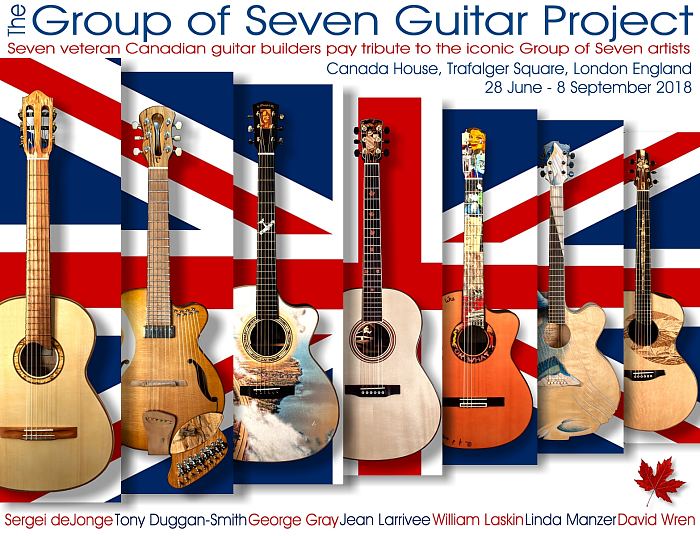
Well … it’s happening … our Group of Seven Guitar Project has crossed the ocean and opened its run at Canada House in Trafalger Square, London England! I still can’t believe the long journey we’ve all been on with this incredible project conceived by Linda Manzer and inspired by the original Group of Seven artists

On November 6th 2018, Linda Manzer flew to the U.K. to do a final presentation on the Group of Seven Guitar Project. To close the show out, Michael Watts played some selections on two of the guitars in the exhibit and Linda was her usual eloquent self … explaining the nuances of each instrument and their connection to each of the original Group of Seven artists.

The Tony MacManus Guitar Summit
What an honor it was to be asked to present an overview of the Group of Seven Guitar Project at Tony McManus’s 12th annual Guitar Summit in Elora, along with Linda Manzer! The reality of the presentation is that I was Vana White to Linda’s Wheel of Fortune (which suited me just dandy) … and she did her usual wonderful job talking about our journey through this great project!

This year’s special guest (as if you need a guitar player any more special than Tony himself) was Ed Gerhard, who has been one of my favorite guitar players for a couple of decades now. If you ever get a chance to attend this intimate workshop … jump at it … what a wonderful learning environment!


Linda Manzer, William Laskin, George Gray, Jean Larrivée, David Wren, Tony Duggan-Smith, Sergei de Jonge
